

30 YEARS

A
MESSAGE FROM THE CHAIR AND PRESIDENT
As the Alliance for Downtown New York turns 30, it is stunning to see how far the neighborhood has come.
In 1995, this was almost a purely financial district. It emptied out after the sound of the closing bell on Wall Street. Today, Lower Manhattan vibrates with more than a thousand shops, restaurants, bars and entertainment venues. It is a 24/7 destination for workers and tourists alike. And now there are some 70,000 locals who call the area home — that’s five times as many residents as there were when the Alliance opened our doors. We have played a major role in driving this transformation. Our public safety officers, sanitation workers and horticulture specialists have helped make Lower Manhattan clean, safe and beautiful. Our economic development team supports our work with in-depth research and analysis. Our communications team highlights the best of the neighborhood across digital platforms, in print and at our events throughout the year. And through our work, we’ve forged meaningful connections with workers, residents and business owners at cultural events, in coffee shops or along our iconic waterfront.
This past year, we met thousands of people at programs like Dine Around Downtown, our summer concert series, the WITS Travel Creator Summit and LM Live. And as we look to next year, we’ll be welcoming thousands more who will enjoy downtown as they participate in celebrations for America’s 250th anniversary and the FIFA World Cup.
Thank you to our members, businesses and partners in government, who share our vision and work with us to help the neighborhood thrive. Thank you as well to the Downtown Alliance Board members, who donate their time and expertise to advance our mission.
It’s an honor and a privilege to serve this community. We invite you to read on, as we celebrate the Downtown Alliance’s accomplishments throughout our three decades. Please join us as we look forward with excitement to making more history together.
Sincerely,
Jessica Lappin President Ric Clark Chair



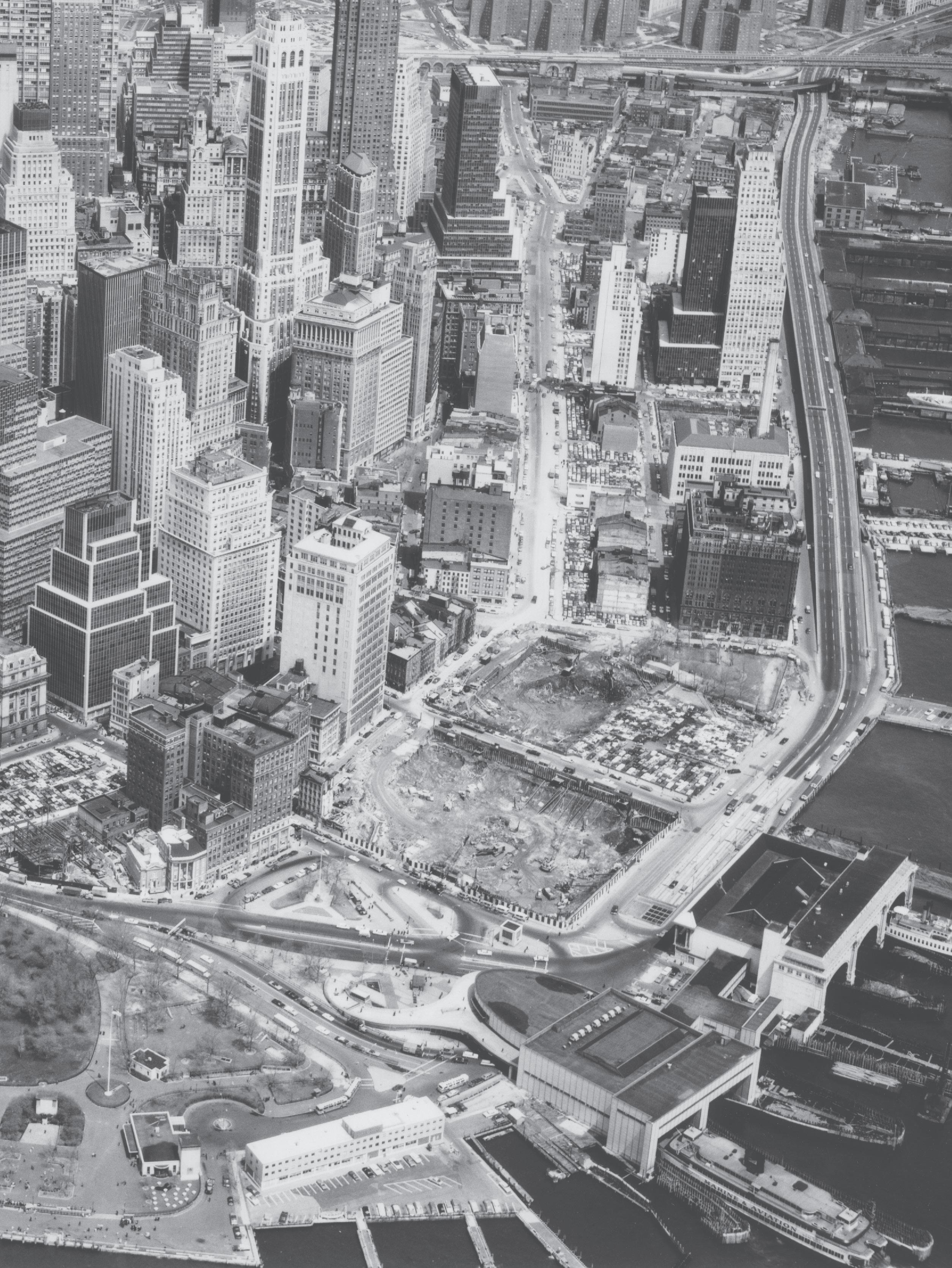

The Downtown Alliance may be celebrating its 30th anniversary, but this story began decades earlier. It all started in 1958, when David Rockefeller created the Downtown-Lower Manhattan Association (D-LMA) to add a mix of businesses, housing and green spaces to the area south of Chambers Street. And so the seed of the Downtown Alliance was planted.
An early D-LMA report in 1958 used the words “erosion, decay and exodus” to describe Lower Manhattan. And things were only slightly better when the Downtown Alliance was founded 37 years later. It’s no secret that things south of Chambers Street were rough in the ’90s. Vacant storefronts covered in graffiti lined empty, poorly lit streets. And with a population of only 14,000, there wasn’t much of a residential neighborhood to speak of.
Some 67 years later, in 1995, a plan calling for the revitalization of Lower Manhattan spurred the creation of the business improvement district known as the Alliance for Downtown New York (or Downtown Alliance) in what William Rudin, one of the Alliance’s founding board members, called “the start of the renaissance” of downtown.
David Rockefeller, reporters and model of the WTC.



During the last three decades, the Downtown Alliance has helped to successfully transform Lower Manhattan from a 9-to-5 business district to a thriving, round-the-clock neighborhood serving locals, workers and tourists alike. We now have 70,000 residents, 44 hotels and countless dining options from food carts to Michelin-starred restaurants. We also have dozens of high-end cocktail bars and dives, sports recreation centers, mom-and-pop shops, shopping malls, 15 parks and green spaces, three movie theaters and even a state-of-the-art performing arts center … we have it all! Lower Manhattan is now home to both established companies and startups across industries like technology, advertising, publishing, architecture, fashion and information services — as well as several colleges and universities preparing the next generation of professionals. But beyond this diversity of industry, the neighborhood also has a bona fide cool factor. Nightlife hotspots like Gitano NYC and Laissez Faire and the WSA office buildings bring a certain je ne sais quoi that artists and celebrities are bringing to Lower Manhattan.
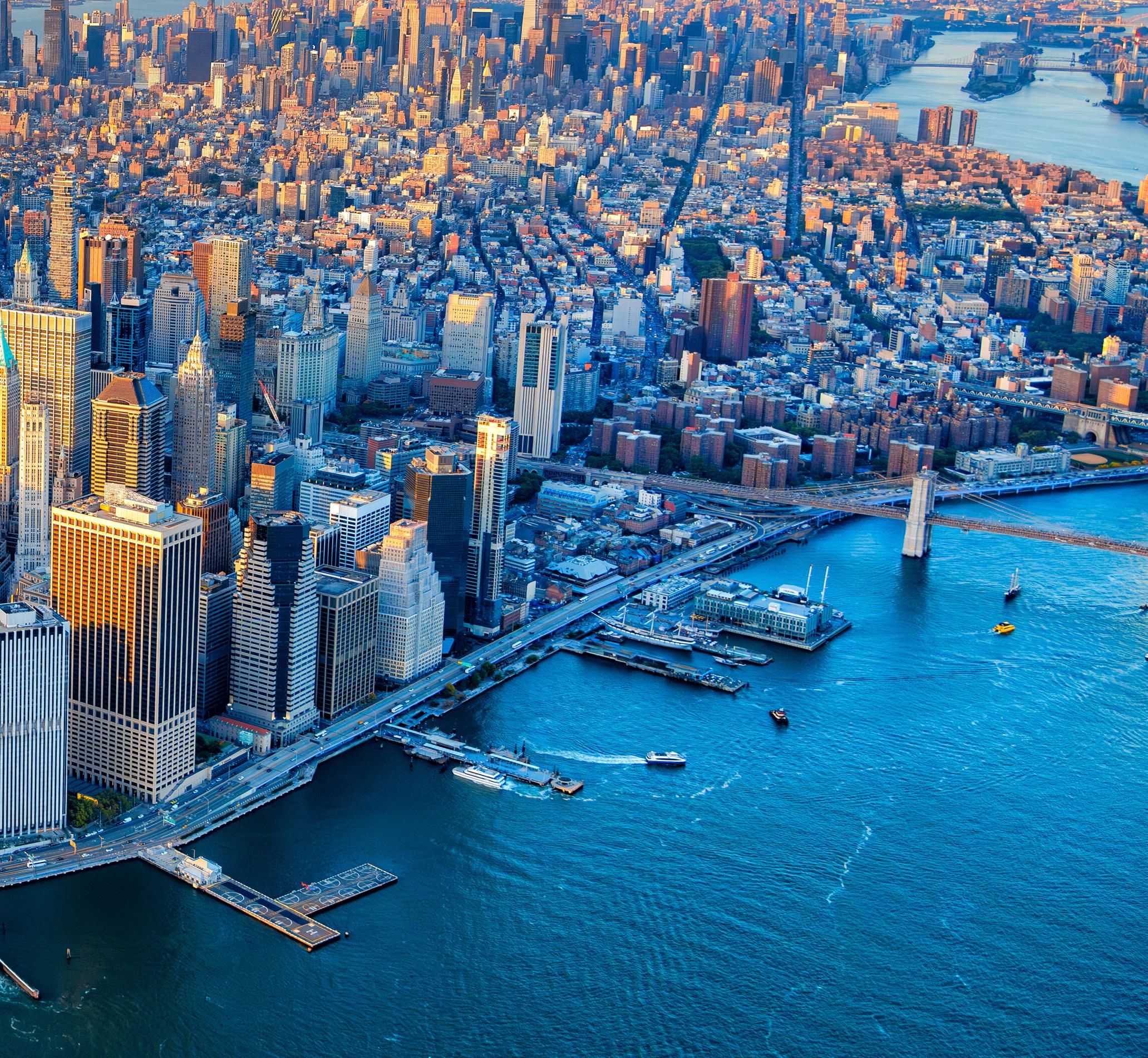

Beyond the work that our constituents can see every day, like our public safety officers and sanitation teams keeping the streets clean and safe, the Alliance also helps mold the policies that shape this neighborhood. Throughout the last 30 years, we have advocated for Lower Manhattan at City Hall and in Albany, helping pass important zoning changes, tax incentives and housing initiatives that encourage neighborhood growth and prosperity.
To celebrate our 30th anniversary, we’re reflecting on many of our biggest accomplishments: pioneering the first conversions of underutilized office buildings to residential housing, our ongoing small business outreach and assistance and helping the neighborhood get back on its feet after unprecedented events like 9/11 and Hurricane Sandy. Consider these pages a roundup of key initiatives that illustrate how the Downtown Alliance’s operations, economic development and communications teams have helped shape Lower Manhattan in the last three decades.
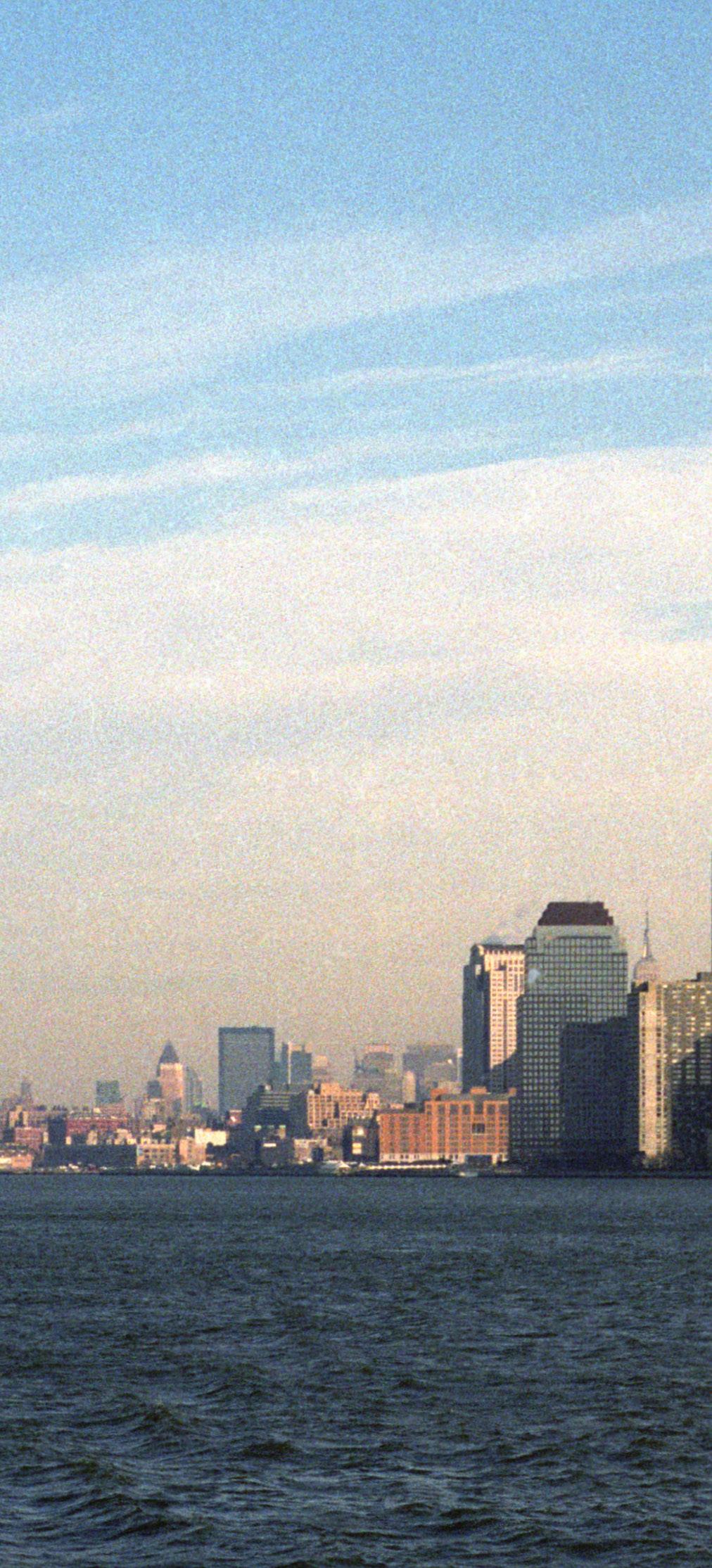
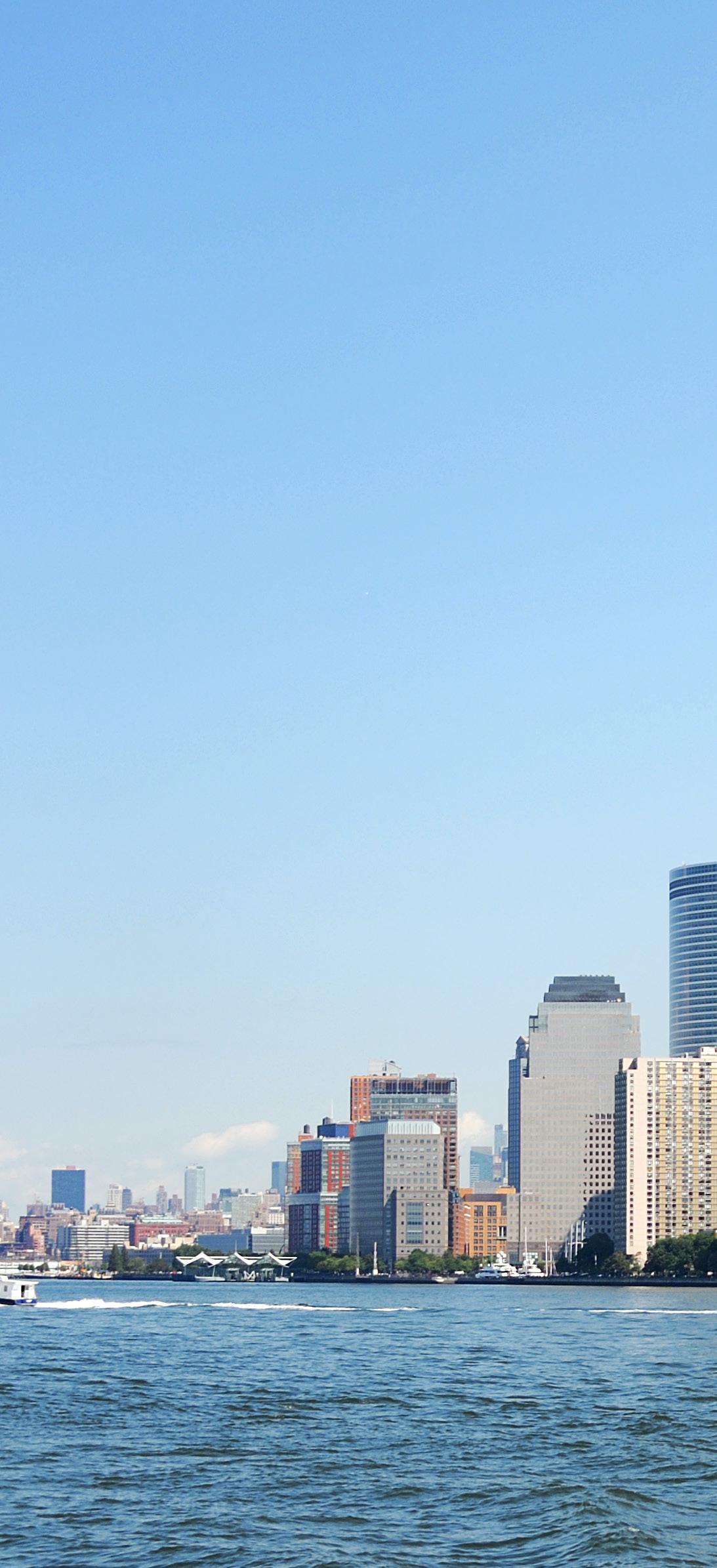




OPERATIONS

Our operations team works tirelessly, day in and day out, to maintain the streets of Lower Manhattan with pride and a smile.
The Downtown Alliance has provided sanitation as one of the core services to our district since 1995. Our 60-person sanitation team keeps Lower Manhattan clean and beautiful by supplementing the sanitation services provided by the city, servicing close to 400 public trash and recycling receptacles on a daily basis.
Our team sweeps the streets and sidewalks multiple times daily to remove litter, and they’re among the first to quickly clear bus stops, fire hydrants, corners and crosswalks to create accessible pathways when it snows. You can find our crews using power washers, scrapers, wire brushes and elbow grease to remove graffiti, stickers and illegal advertisements around Lower Manhattan.
In addition to our sanitation services, the Alliance works to keep Lower Manhattan safe. Our public safety officers serve as ambassadors for the neighborhood and are constantly on alert to help deter crime and assist our community. Our team of 50 public safety officers patrol the streets 24 hours a day, seven days a week they connect businesses and pedestrians to city and non-city agencies for assistance — everything from helping the NYPD apprehend a suspect to giving directions to tourists. In 2024 alone, for example, our public safety officers had 172,000 interactions with the public that addressed a wide range of quality-of-life conditions and community concerns.

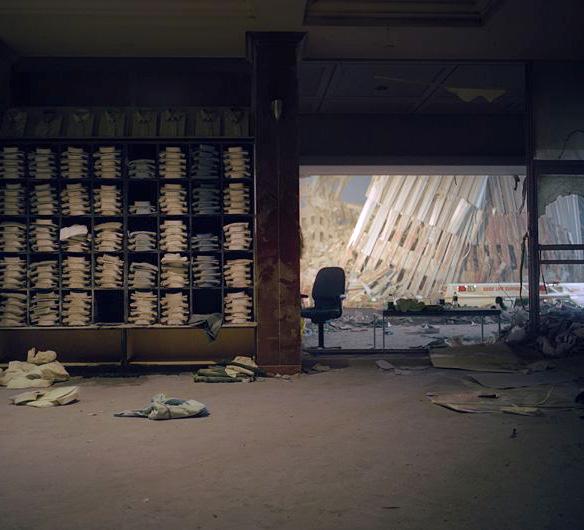
In the immediate aftermath of September 11, 2001, the Downtown Alliance turned its Downtown Center (just two blocks south of the World Trade Center) into a triage ward. Our public safety officers tended to the wounded and gave refuge to those who needed it. We let people take showers and turned our conference room over to first responders, even allowing FDNY to use our radios. In the days, weeks and months that followed, our operations team (along with countless other individuals and organizations) worked hard to restore a sense of normalcy downtown.
Brooks Brothers on September 11, 2001.
The Downtown Alliance has deployed Bigbelly solar-powered trash compactors and accompanying recycling receptacles throughout our district for more than a decade — in fact, we were among the first in the nation to use this technology as part of a three-month pilot program in 2012. Now, we operate and maintain 178 of these paired units, which allows us to divert one-third of the neighborhood’s waste from public spaces into recycling. These innovative compactors have also dramatically cut down on the number of trash bags that need to be collected and containerized for pickup by the city.

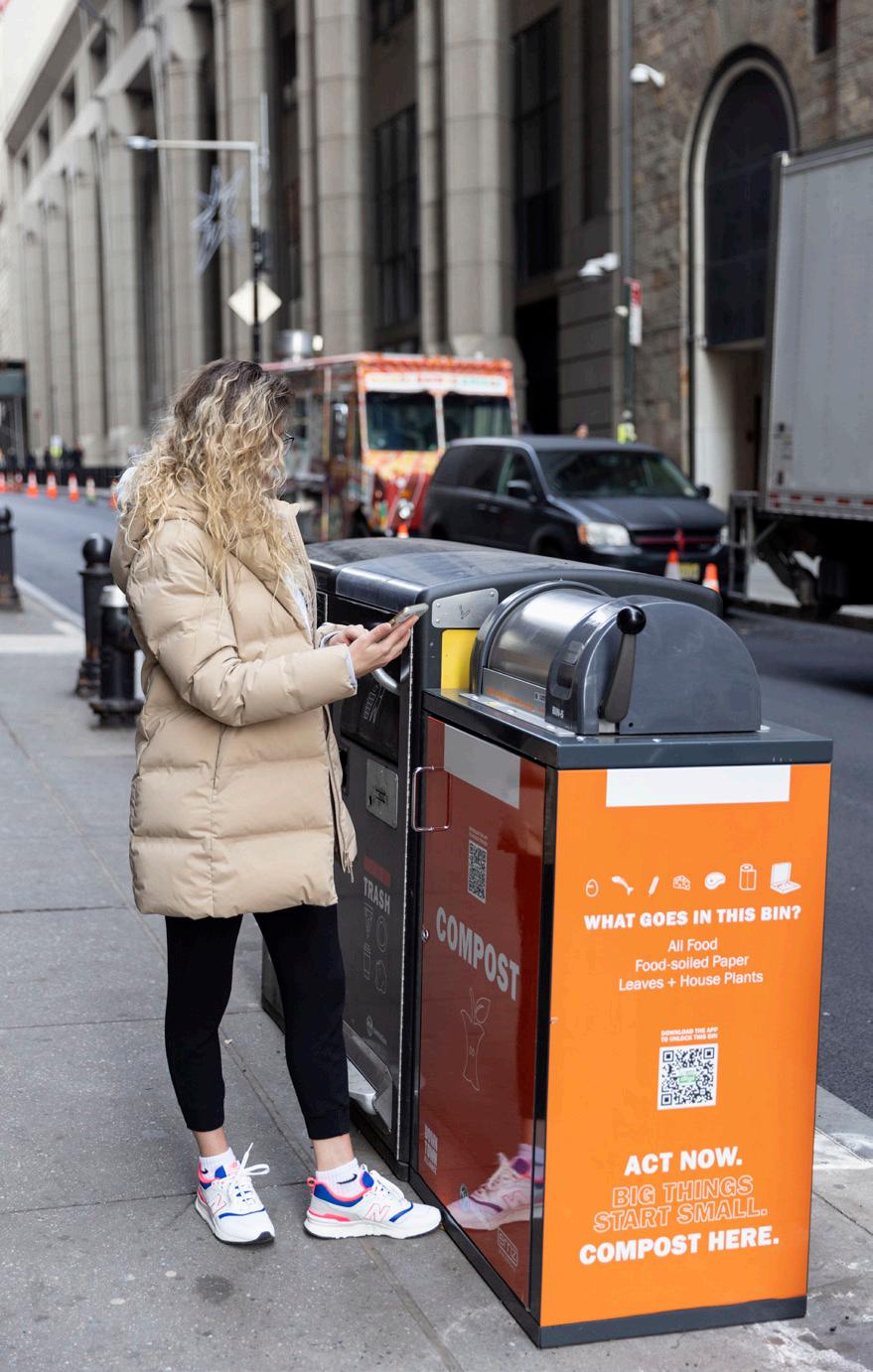
In 2024, we collected more than 1000 tons of trash and over 324 tons of recyclables — that’s more than 60 elephants worth of recycling.
The Downtown Alliance also hosts our Shred-a-Thon community recycling events each year, typically one for electronic waste in the spring and textiles in the fall, paired with a mobile paper shredding truck. These popular events are always well-attended and well-received.
In December 2021, the Downtown Alliance partnered with the Department of Sanitation to launch NYC’s first app-enabled public composting pilot program, which was also the first in the nation to utilize mobile technology for secured access, making drop-off composting easy and accessible to the public 24/7 while keeping rats at bay.
The 18-month pilot program kept more than 105,000 pounds of organic waste from the neighborhood out of landfills. After the success of our pilot program, the Department of Sanitation was inspired to deploy its own Smart Composting Bins across the entire city, including 11 right here in Lower Manhattan. Now, all New Yorkers have the opportunity to compost their food waste because of the Alliance’s early efforts.

Since 2009, Trinity Church and Bowery Residents’ Committee (BRC) have worked in partnership with the Downtown Alliance helping people experiencing homelessness in Lower Manhattan by supplementing the work of the city’s Department of Homeless Services. Trinity Church provides support by supplying one-half of the yearly funding for BRC to conduct outreach, advocacy and other services to individuals in need throughout the Downtown Alliance’s boundaries.
These services include stabilization beds, public and private shelters, drop-in centers and hospital care. From July 2009 to January 2025, we helped place 1,100 individuals into various shelters. These placements have helped transition individuals from sleeping on the streets and subways to essential services that support them in reclaiming their lives and achieving their potential.
In addition to our day-to-day work with BRC, in 2024, we teamed up with the organization to run two book and DVD drives, with donations going to residents at various BRC housing locations.
To make getting around Lower Manhattan easier, the Alliance created a free jitney service in 1996. In 2003, the Alliance’s bus service was expanded and rechristened as the Downtown Connection, a free bus service in partnership with Battery Park City Authority that provides easy access to major downtown destinations like Battery Park City, Brookfield Place and the Seaport. In its 22 years of continuous operations, the shuttle has provided more than 7 million rides to residents, workers and visitors alike.
Our iconic bright red buses, each with seating for 22 passengers, operate daily, making 36 stops around the perimeter of Lower Manhattan. Service runs from 10 a.m. to 7:30 p.m., with arrival times averaging around every 15 minutes, and no fare necessary.

For more than 25 years, we’ve provided and maintained the outdoor seating at Water/ Whitehall Plaza, Coenties Slip Plaza, Gouverneur Lane, Albany Plaza and the bump-out on Broad Street by Exchange Place. Our crews put these tables and chairs out daily for the public to enjoy from spring until the holiday season, weather permitting.

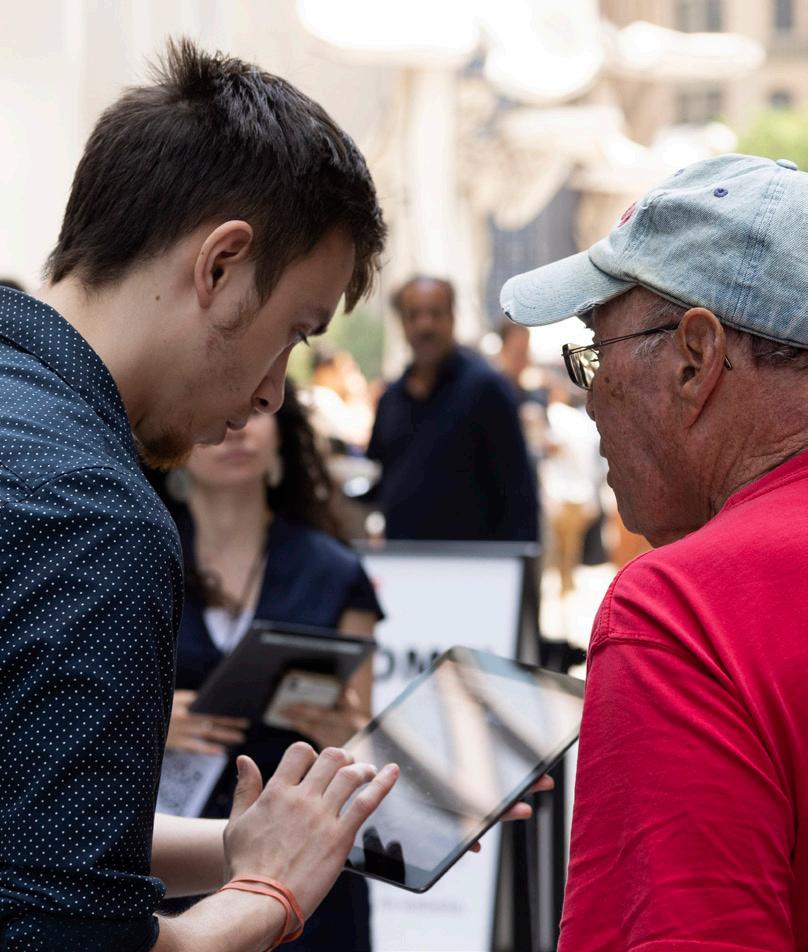
Starting in 1999, through the early aughts, the Alliance beautified 26 blocks via the Broadway Streetscape Program, adding and replacing fixtures including light posts, pedestrian ramps, bike and hydrant bollards and more. This $20 million program (made possible in part by a grant from the Lower Manhattan Development Corporation, funded through community development block grants from the U.S. Department of Housing and Urban Development) partially included replacing the old green-and-white street signs with distinctive black-and-white ones featuring images of the closest Lower Manhattan landmarks. Beyond aesthetics, we’ve also upgraded the street signs on main thoroughfares to be illuminated for improved visibility and wayfinding. Today, the Alliance maintains more than 900 pieces of fixed assets, including these signs, throughout the district.
And while outside, the public can also surf the web courtesy of the Downtown Alliance. We began offering free Wi-Fi in Lower Manhattan in 2003 with seven hotspots around the neighborhood. Since then, we have connected more than 6 million devices and transferred more than 100 terabytes of data (enough to stream nearly 25,000 hours of TV!). Today, we provide about 7 million square feet of free Wi-Fi throughout the district with our 29 Wi-Fi hotspots.
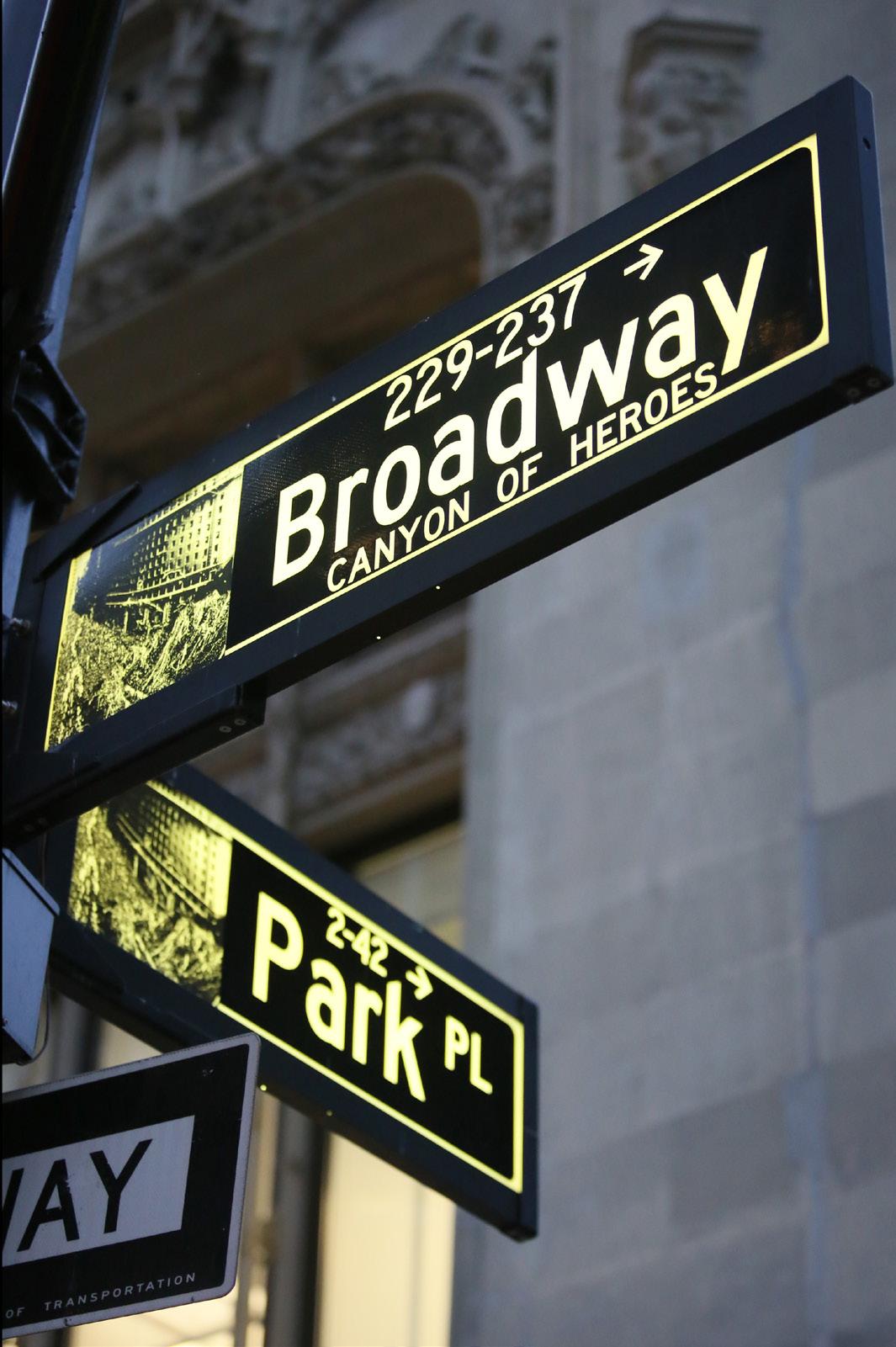

The Alliance’s dutiful horticulture team designs and maintains the district’s landscaping, which includes greenery, flowers and seasonal plantings at Bowling Green, Mannahatta Park and Elizabeth H. Berger Plaza. This work is supported in part by a grant from Con Edison for sustainable communities. Our team also oversees seasonal planting designs for light pole baskets above Broadway and Nassau Street. In addition, we maintain more than 100 DOT planters by Bowling Green, Albany Plaza, Gouverneur Lane, the NYSE security zone and other locations throughout the district, as well as 23 rectangular planters along Greenwich Street. Our signature Greenwich Street planters add much-needed greenery along the corridor and help the neighborhood feel like home.
Soldiers. Kings. Sea captains. A pope and a concert pianist. Since the first ticker-tape parade was held in 1886, Broadway has hosted 209 marches celebrating sports wins, dignitaries and achievements of all shapes and sizes. And since 1995, in addition to being responsible for sourcing all that confetti, the Downtown Alliance’s public safety team has monitored the crowds and our sanitation team assists the Department of Sanitation with cleanup after. We have also installed granite strips along the parade route from the Battery to City Hall to commemorate each of these parades, most recently for the New York Liberty’s 2024 WNBA Championship win!

Number of Downtown Connection riders: 251,639 FY 2025 by the Numbers
Number of individuals ADNY and the BRC Homeless Outreach team placed in transitional housing: 210
Tons of trash and recycling collected: 1,083 tons of trash and 352 tons of recycling
New York Liberty ticker-tape parade in October 2024.

Several times a year, our horticulture team also offers the public the opportunity to get their hands dirty with a volunteer program to help keep our green spaces looking their best. And budding gardeners line up around the block for our annual free plant giveaways, where attendees can take our out-of-season plantings from Bowling Green home with them.


Over the course of the Alliance’s 30-year history, Lower Manhattan has faced an array of challenges. But in March 2020, when Covid-19 hit, our operations team stepped up to help. We distributed tens of thousands of masks to local businesses, restaurants and schools, installed sanitizer dispensers to Bigbelly units at 20 locations near subway stations and other highly trafficked pedestrian areas. We switched out dozens of handle-operated Bigbelly trash compactors with ones featuring a hands-free, hygiene-friendly foot pedal. In addition to these and our robust economic development initiatives, we also replaced our old Downtown Connection fleet with a new operator and a slate of buses complete with an interior configuration and air filtration system designed to better mitigate communicable airborne disease.
Number of public safety officer contacts with the public:
242,461
Amount of confetti supplied for the 2024 ticker-tape parade: 2,000 lbs
ECONOMIC DEVELOPMENT

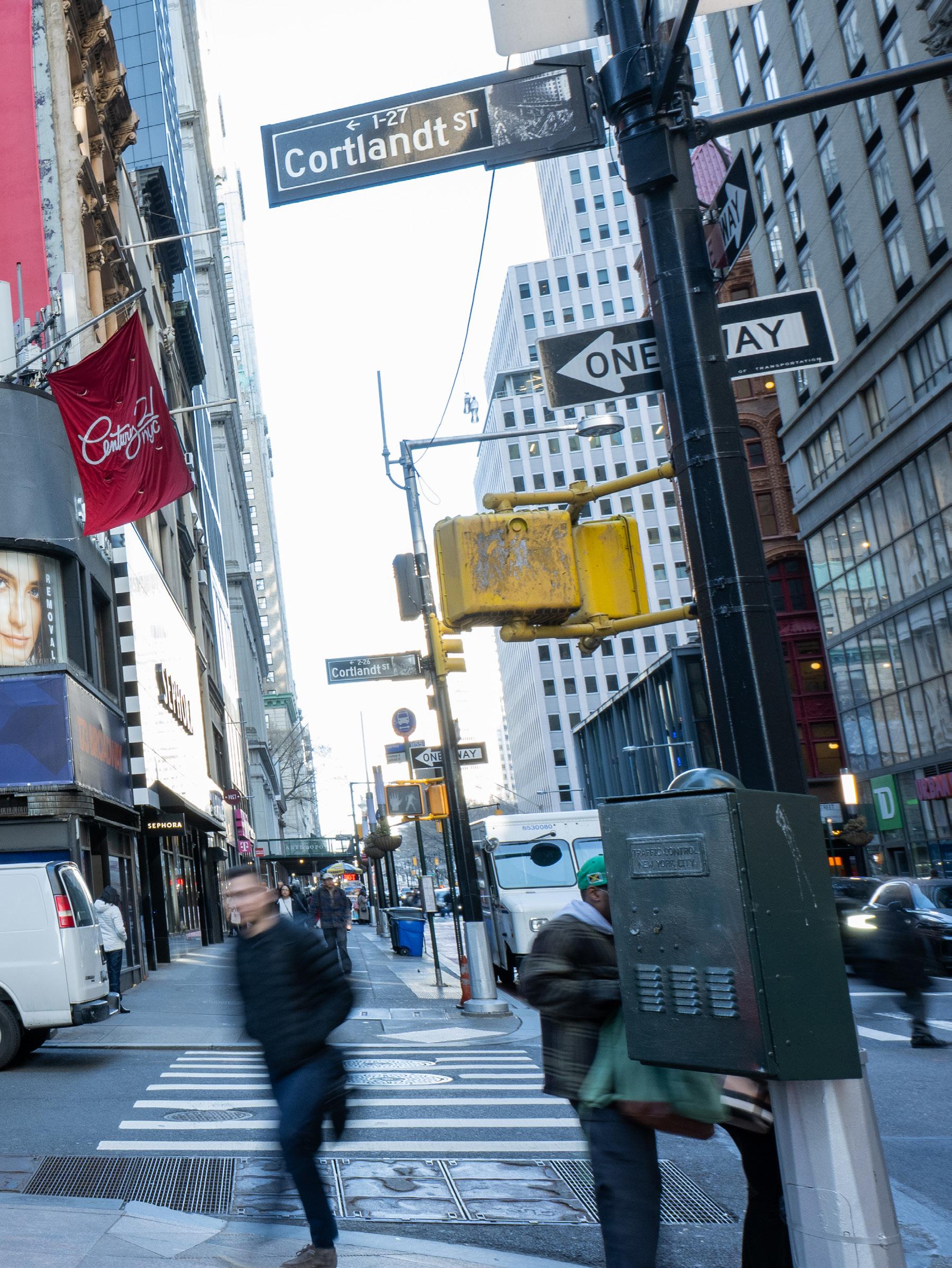
ECONOMIC DEVELOPMENT
By conducting rigorous market analysis, tracking vacancy rates, working to attract new commercial and retail tenants, carrying out programming and planning and producing a series of incisive, original research reports on a variety of real estate and other trends, the Alliance’s economic development team has provided a strong foundation for the organization’s advocacy efforts for decades.

Since 2000, the team’s robust research program has analyzed real estate and economic trends in Lower Manhattan, releasing quarterly reports on commercial leasing trends, residential and hotel developments, retail openings and other significant capital improvements occurring throughout the neighborhood. In addition to these quarterly updates, our research team has produced special reports on larger trends over the years that have included pandemic recovery, return to office, worker satisfaction, downtown commuting, bike infrastructure, residential demographics, pedestrian counts and more.

In 2012, the Alliance released
“The Brain Gain” report, highlighting Lower Manhattan’s strategic location in relation to new waves of professional workers in the neighborhood, as well as an influx of educated young and mid-career adults. Reports like these, including 2015’s “Surging Ahead: Lower Manhattan’s Economic Revival and What It Means for New York,” helped change the conversation around real estate in Lower Manhattan.
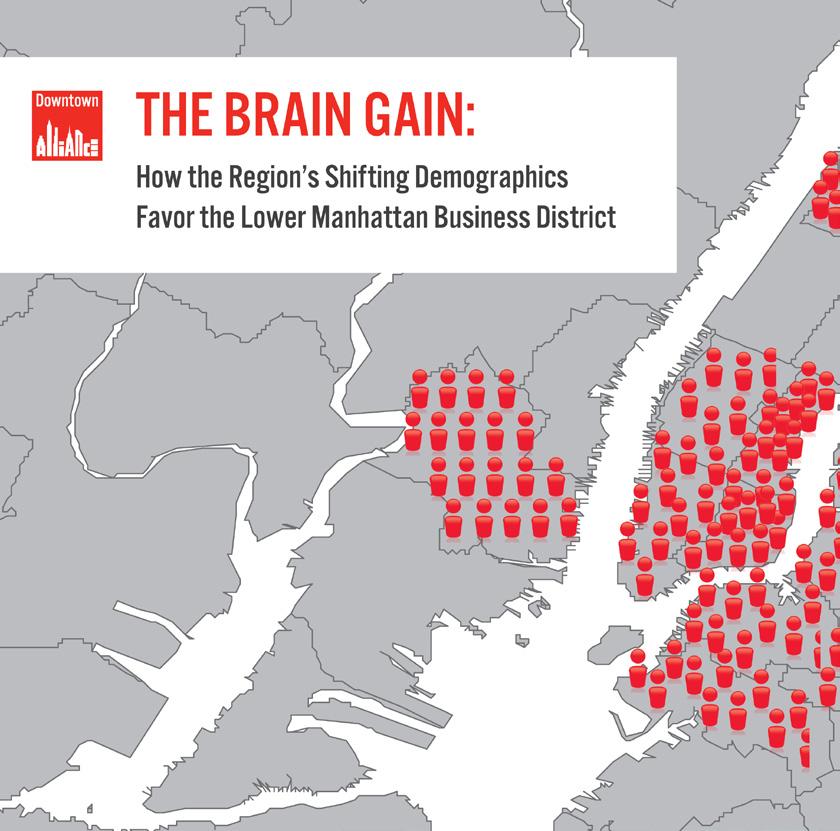
Our location-specific data collection makes us a sought-after resource for local reporters, brokers, developers and others interested in keeping tabs on and investing in Lower Manhattan’s real estate industry.
We track retail vacancies and our team also works closely with brokers to market Lower Manhattan as a retail and commercial destination. In 2025, we launched the Commercial Low Down newsletter specifically tailored for real estate professionals, which highlights positive developments and encourages investment and growth in the area.

In the last 30 years, Lower Manhattan’s economic landscape diversified and flourished. Through strategic investments and our collective marketing efforts, the Downtown Alliance has been instrumental in the neighborhood’s transformation toward today’s roster of commercial tenants. In 1999, for example, the area’s only Amish Market opened its doors at Washington and Cedar streets. Subsidized by residential developers at the urging of the Downtown Alliance, the store became the neighborhood’s first full-service gourmet food market. Today, an influx of residential buildings downtown has led to more grocery stores, food and drink offerings and personal services in the district.
And Lower Manhattan’s corporate landscape has also flourished since the ‘90s. In 1997, we started the Plug ‘n’ Go program with the New York City Economic Development Corporation (EDC) to attract high-tech companies with affordable downtown office space prewired for internet use, in what was then a rare and valuable commodity. With hundreds of leases signed and thousands of employees brought into the area, this novel program was instrumental in attracting companies to Lower Manhattan during the dot-com boom and can also be credited with helping to significantly lower the area’s Class B and C commercial vacancy rates.
With the Alliance’s help, the neighborhood’s office demographics began to shift away from a majority of financial services companies to include a mix of creative and tech industries. After the success of the Plug ‘n’ Go program, the Downtown Alliance sought ways to foster the growing, diversified worker community.


In December 2009, we launched the Hive at 55, a 4,000-square-foot coworking facility at 55 Broad St. for small businesses, freelancers and entrepreneurs. This was an innovative concept, predating the vast expansion of coworking spaces across the globe. In just a few years, the Hive at 55 attracted hundreds of members while helping businesses develop and grow.
With the success of the Hive at 55, we looked for more ways to support different industries downtown. In 2013, as the tech industry grew in the neighborhood, we introduced LaunchLM, a community initiative designed to care for, connect and attract tech businesses, predominantly by offering programming like lectures, networking events and happy hours for downtown tech denizens.
In 2015, these two initiatives came together as LMHQ, a cross-sector collaboration space at 150 Broadway. The 12,500-square-foot hub included a 140-seat event space, conference rooms, phone booths and customizable workspaces with plug-and-play flexibility. Memberships were offered at more reasonable rates than local competitors, and LMHQ offered a robust slate of programming intended to gather and engage industry professionals including the Women’s Breakfast series. We also offered private professional development workshops, collaborative programming with outside organizations and even a partnership with HarperCollins for author events. LMHQ also teamed up with Con Edison for the Bright Ideas grant program, which gave NYC nonprofits the opportunity to use LMHQ’s event space and meeting rooms for free. It was a bold initiative and a great success, and the space closed in 2022.
The Alliance unveiled an innovative coworking space called the Hive at 55 in 2009.
LMHQ
By 2020, the percentage of Lower Manhattan’s corporate tenants from the financial, insurance and real estate industries dipped under 30%, as notable companies in the tech, advertising, media and information sectors moved in. These included Spotify, Uber, Condé Nast, HarperCollins and WPP, which established themselves as downtown tenants and neighbors, along with major stakeholders like the Seaport Entertainment Group, Brookfield Place and, recent newcomer, French luxury retailer Printemps.
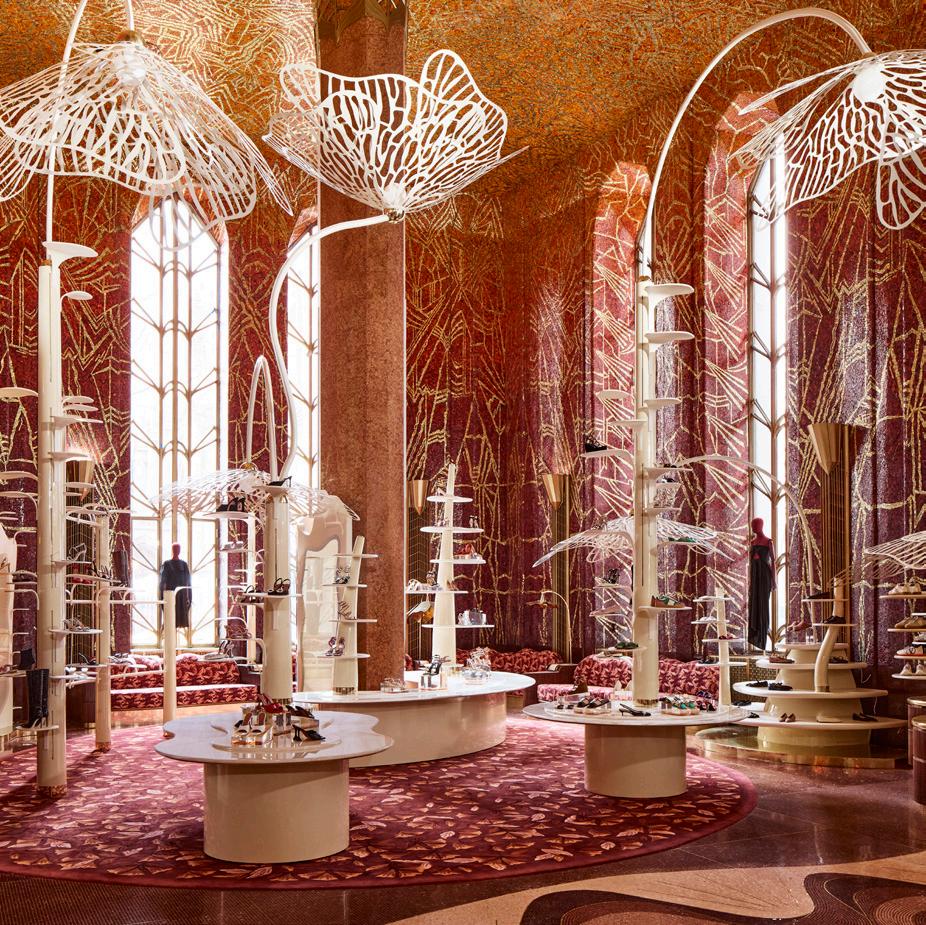
In 1658, Stone Street was New York’s first paved street. In 1996, it became a NYC historic landmark. Between these two milestones, however, the area had fallen into disrepair and was largely abandoned. Still, the Downtown Alliance saw its potential, and in 1996, we partnered with the Landmarks Preservation Commission to designate Stone Street as a historic district, a move that allowed the Commission to apply for federal funds to restore the street. We also teamed up with the city’s Department of Transportation and Department of Design and Construction to bring Stone Street back to life.
The Downtown Alliance coordinated the Stone Street reconstruction: The city installed a new street bed lined with cobblestones and also laid new bluestone sidewalks and a granite curb. Old-worldstyle lighting fixtures were also installed for outdoor diners to enjoy in the evenings. The revitalization project was completed in 2000, and since then, Stone Street has maintained its historic character while reinventing itself as a hotspot for the city’s biggest St. Patrick’s Day and Oktoberfest celebrations.

Printemps
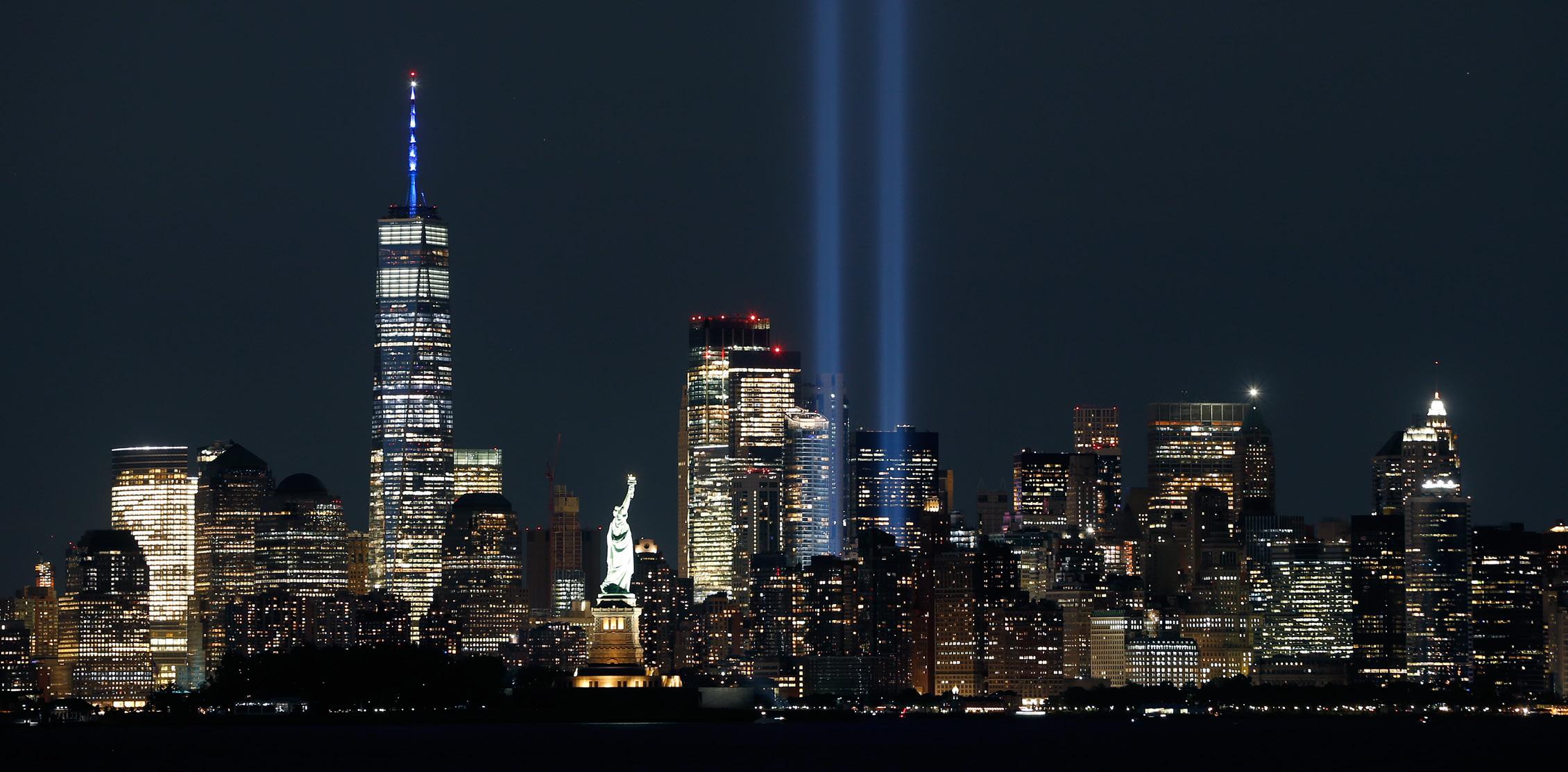

Nearly 25 years on, September 11 is rightly remembered as an enormous tragedy. In the days following the cataclysm, the Alliance and its partners quickly launched a $10 million program to help small neighborhood retailers rebuild and reopen. Lower Manhattan had, by some estimates, a $54 billion hole in its economy, which had lost tens of thousands of jobs across all sectors, with the financial industry being the hardest-hit.
In order to keep area small businesses afloat, the Alliance worked with another nonprofit, Seedco, to create a grant, loan and wage subsidy program. All told, $37.5 million in aid was distributed under the program to repair or rebuild small businesses devastated by the attacks. This money was essential in filling the gap before government aid was available.
"Tribute in Light"

Post-9/11, a promise was made to rebuild Lower Manhattan. The reconstruction period came with challenges — including the many challenges that served as temporary eyesores. So in 2007, the Downtown Alliance started a forward-thinking initiative to mitigate the visual clutter of the rebuilding, as well as to support local artists, called Re:Construction. Thanks in part to a $1.5 million grant from the Lower Manhattan Development Corporation, the program successfully repurposed construction barriers as large-scale canvases for temporary public art. Lower Manhattan’s sidewalks became more pedestrian-friendly, while scenic and thoughtprovoking art was integrated into daily life.
In 2009, we released “Five Principles for Greenwich South,” a rigorous visioning study that presented guidelines for making the 23-block area south of the World Trade Center site an even livelier and more densely packed community.
The impact of our study was widespread, resulting in the creation of new public spaces, hundreds of custom-designed planters and street furniture for the neighborhood to enjoy. One major win was the new Robert R. Douglass Bridge, named after our founding chairman, funded by the Lower Manhattan Development Corporation and Battery Park City Authority. The pedestrian bridge designed by WXY Architects + Urban Design opened to the public in September 2019 to replace the interim Rector Street Pedestrian Bridge that was installed as a temporary replacement to those damaged or destroyed in the attacks on September 11, 2001.
Another realized outcome of our Greenwich South study was the creation of Elizabeth H. Berger Plaza. We joined with Community Board 1 and local parents and residents to advocate for the transformation of Edgar Plaza into a unified park that could serve as a pedestrian link between Ground Zero and the Battery. In 2021, the new Elizabeth H. Berger Plaza was completed on the site. It is named for the Alliance’s late president who advocated for the creation of the plaza and whose steadfast efforts helped shape Lower Manhattan to become the neighborhood it is today.
Similarly, we released a detailed plan to strengthen the underutilized Water Street corridor in 2011. Our economic development team made strides to implement our vision and worked closely with city agency partners to pursue a zoning action that would allow for enhanced retail on this important commercial thoroughfare.

Re:Construction

In October 2012, the neighborhood faced another setback as Hurricane Sandy caused havoc. Downtown was flooded with millions of gallons of water, submerging tunnels, businesses and homes and knocking out electricity, telecommunications and subway lines. After the storm hit, the Alliance led a major response that included a “Back to Business” program, which provided a total of $1.6 million in grants to 105 small businesses that had been affected. Of this amount, $1 million came from our own reserves. The rest was contributed by large local companies assisting their neighbors.
The Alliance also launched a program to provide free Square mobile card readers to assist affected Lower Manhattan businesses ring up sales. This addressed an immediate challenge many businesses faced in restoring their individual telecommunications systems ahead of the 2012 holiday shopping season. These early initiatives — coupled with the Alliance’s ongoing push for the city and state to invest in sustainability measures that would prevent future storms from devastating the neighborhood — were crucial in helping downtown businesses get back on their feet after such an unprecedented climate challenge and to prepare them for the storms of the future.
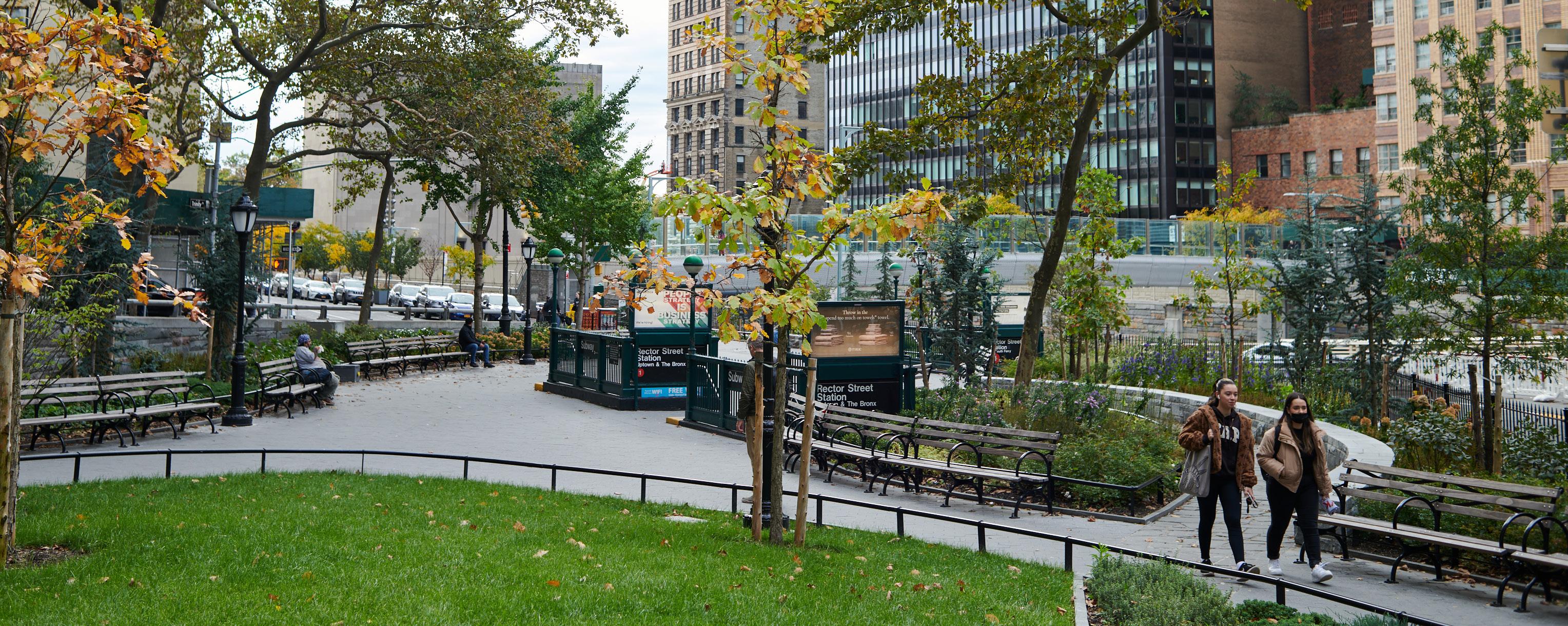
The cover photo of New York Magazine following Hurricane Sandy.
Elizabeth H. Berger Plaza

During the Covid-19 pandemic in spring of 2020, businesses shuttered, leasing and development slowed, employment dropped and tourists stayed home. Our small businesses were hit especially hard.
The Alliance’s economic development team mobilized, developing and implementing an $800,000 Small Business Rental Assistance Grant Program, which provided direct support to struggling Lower Manhattan retailers. We approved 61 awards that helped cover storefront rents for April and May of 2020. The Alliance also launched a Small Business Technical Assistance Program, which provided free one-on-one technical assistance sessions to Lower Manhattan small businesses. We partnered with Streetsense, a well-regarded retail consultant, to assist restaurants and retailers in reconfiguring their spaces to meet social distancing and new hygiene guidelines. Streetsense also produced two detailed Covid recovery toolkits for businesses downtown: 31 businesses received consulting sessions worth $1,500 each and we provided $3,000 implementation grants to 27 businesses.
The Alliance partnered with BentoBox in 2021 to create the Online Ordering Sponsorship Program, which provided restaurants with their own delivery and takeout platforms in an effort to separate them from third-party services, which take bigger cuts of sales. The program included a virtual orientation, one-on-one training for each restaurant and additional periodic webinars to receive restaurant feedback on aspects of the program that could use improvement. The program covered a full free year of services, including ongoing technical and marketing support.


Our business grants didn’t end once the worst of the pandemic eased. In the spring of 2022, we launched a new business assistance program called Get Social. The Alliance paired 10 businesses with social media consultants, each of whom demonstrated skill and strategic insight in building an audience on a variety of platforms. We provided each participating business with six hours of consulting services, as well as a $1,500 grant to spend on digital advertising and a 45-minute professional photoshoot to help them with their image. The program was such a success, it spawned multiple cycles of grant making.
To ensure we’re always connected with and available to assist our small businesses throughout the district, the Alliance has a dedicated director of storefront business engagement on staff who serves as a liaison to the community through site visits and regular communications. We’ve connected our local business owners and operators with valuable resources from the city and state on everything from how to apply for outdoor dining permits to spreading the word about free tax preparation services, and we hosted special events for networking and educational purposes.
Number of quarters that the downtown market’s available office space continually decreased: 7
Small business survey respondents who reported their revenue has fully recovered from the Covid-19 pandemic: 56.4%



The Downtown Alliance’s communications team celebrates the neighborhood like a proud parent and shares everything from local news, events and profiles on downtown businesses. Quite rare for a business improvement district, we have a dedicated in-house team to share what’s happening in the neighborhood on our website, social media platforms, a quarterly print newsletter and our weekly email newsletter, which has a circulation of 32,000 devoted readers.

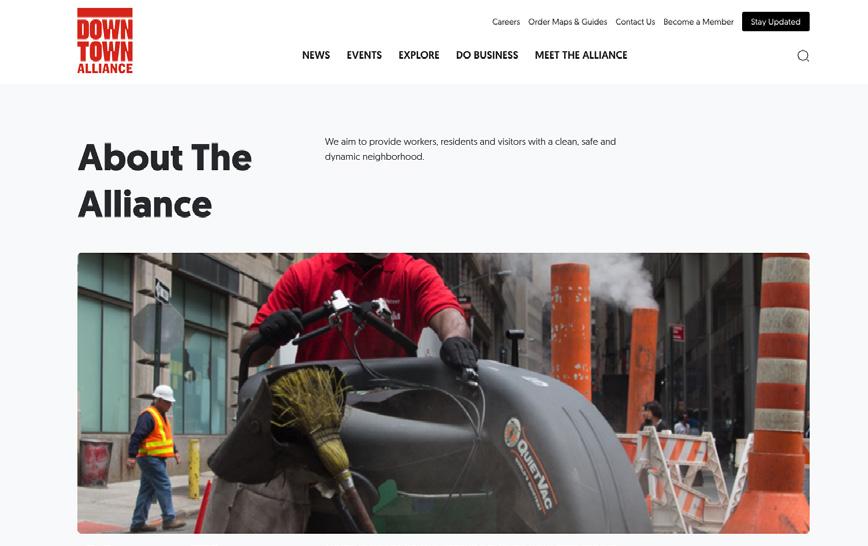

Our commitment to supporting small businesses directly translates to our love of storytelling on our website, with the need-to-know updates of a local news site and the distinctive voice and dynamic visual style of a magazine. This is an indispensable resource for small businesses, workers, tourists and residents alike. In addition to sharing organizational news and events, our targeted focus south of Chambers Street allows us to tell important stories about the neighborhood that might not make it in other local news outlets, like our “Portraits From the Pandemic” series that profiled essential workers and businesses as they navigated day-to-day challenges. We also featured a Legacy Business series, telling the stories of businesses that have operated in Lower Manhattan more than 25 years. And we regularly publish guides, itineraries and roundups that simultaneously help visitors and locals navigate the neighborhood as well as boost downtown’s businesses and landmarks.




As social media evolved, so too did the Downtown Alliance’s online presence. We posted some of our first digital content on platforms like Twitter in 2009 — more than 25 years and nearly 75,000 followers later (on Instagram alone), we’re still finding creative ways to share our neighborhood with our audiences. Our most viral Instagram post ever in summer 2023 amassed nearly 100,000 likes. While we do like to have fun and stay relevant on our channels, we do so while furthering our economic development initiatives, whether connecting with local businesses or running targeted LinkedIn campaigns for commercial real estate changemakers.
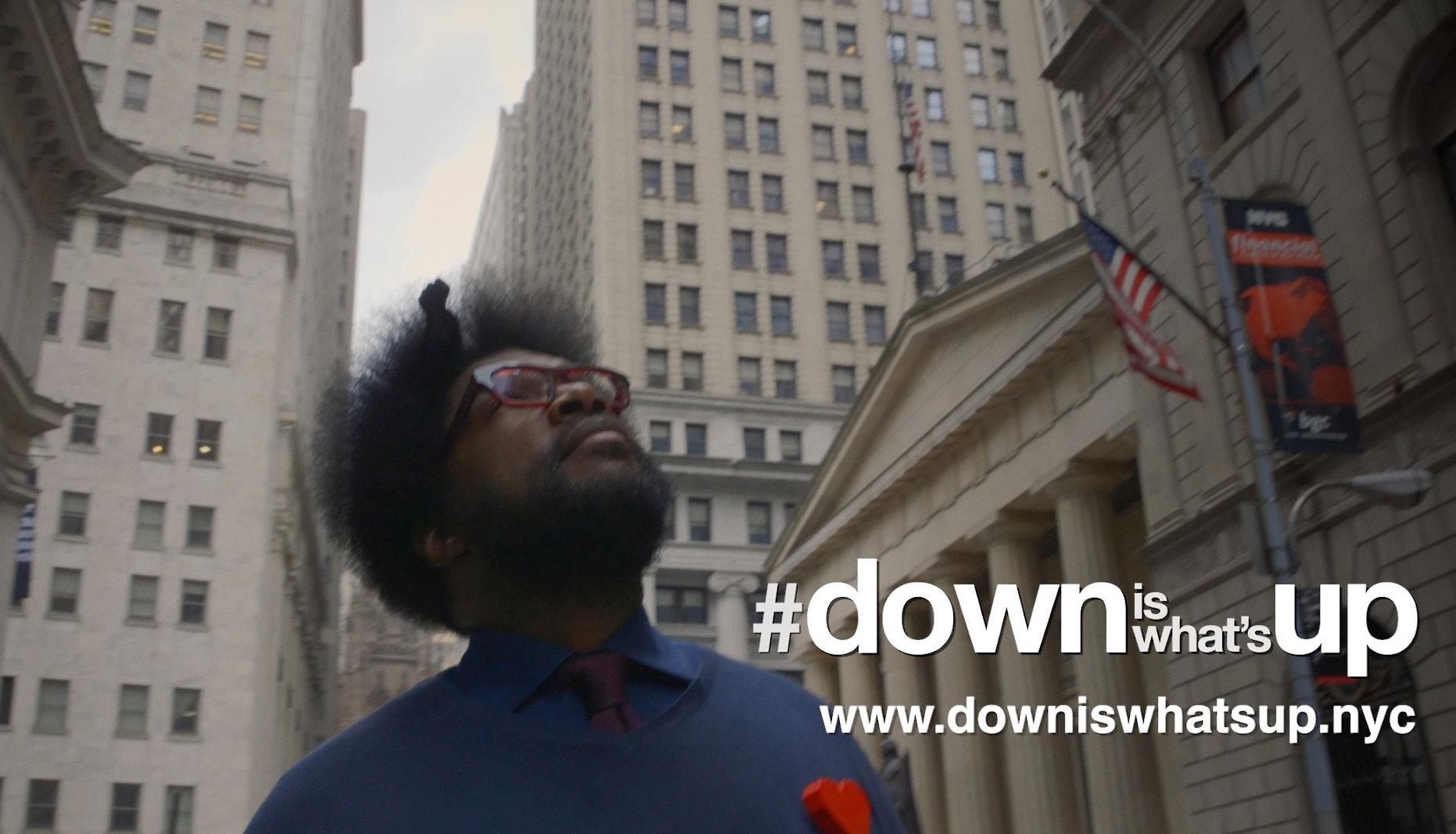


The Downtown Alliance has rolled out a steady stream of integrated marketing campaigns over the years to emphasize the neighborhood’s appeal to workers, tourists, residents and key real estate decision-makers. In 2015, we unveiled the “Down Is What’s Up” campaign, which included a viral video about Lower Manhattan’s transformation featuring Questlove. In 2024, we launched our colorful “Do You Downtown” campaign. Also in 2024, we rolled out the “Only Downtown” out-of-home campaign, a collaboration with Lower Manhattan-based ad firm Wunderman Thompson. On the streets of Lower Manhattan, all you have to do is look up (at the light pole banners) or down (at the Bigbelly trash cans) to see our latest campaigns.

During the past several years, the Alliance has created several first-of-its-kind campaigns that net significant public engagement by doubling as contests. In early 2020, we launched the “Explorer-in-Chief” campaign, seeking a photographer to live downtown rent-free for a summer and work as a travel ambassador in one of the world’s high-profile tourism destinations. Our first Explorer-in-Chief, photographer Josh Katz, moved into Mint House in summer 2021 and captured the neighborhood for three months during its post-Covid recovery.

Downtown has also become a major filming destination for TV, movies and editorials. So in 2024, we launched a “Filmmaker-in-Chief” campaign, seeking filmmakers to create a short film featuring Lower Manhattan; our winners, Andrew and Remy Neymarc, shot the short “Dreamscape” in the fall of 2024, which has since won the award for Best Drama at the New York Shorts International Film Festival. In 2024, we also executed an award-winning walking tour incubator program that helped develop five new walking tours that go beyond typical tourism market offerings.


Despite ebbs and flows, Lower Manhattan’s tourism scene has also expanded dramatically in the last few decades, and we’ve expanded our tourism practice to meet us at the current moment. Today, we have 44 hotels downtown with hundreds more rooms in the pipeline. As the most historic neighborhood in New York City, downtown is full of fascinating museums, landmark sites, architectural wonders and much more — plus, thanks to this increasingly robust hotel scene and connected public transit system, it is now the most convenient place to base a stay in the city.
After years of post-9/11 recovery, the Great Recession of 2008 took some wind out of Lower Manhattan’s sails, resulting in job losses, reduced business revenues and reduced tourism. But once again, Lower Manhattan rebounded. Tourists returned in droves — more than 9 million visitors alone in 2010, a 26% increase from 2008. Then and now, the Alliance has worked to bolster tourism, because part of our job is to make
The Beekman Hotel

Lower Manhattan known as a top-tier destination, keeping domestic and international visitors’ attention and dollars in the area, manning information kiosks, promoting hotels and tourist attractions and marketing directly to international tourism conventions.
In 2010, we also began holding roundtable meetings with tourism stakeholders downtown, which we’ve since broadened to larger, quarterly tourism exchanges where scores of industry professionals learn about the latest happenings, trends and data relevant to the downtown tourism space.

Tourism Exchange, 2023


We also regularly attend national and international travel trade shows to provide detailed information on visiting Lower Manhattan to tour operators and group travel planners. Our representatives highlight the latest attractions, distribute thousands of visitor guides and arrange for tours and hotel stays with downtown destinations.
But in May 2025, we tackled one of our biggest tourism undertakings yet: hosting the WITS Travel Creator Summit, which brought more than 600 women travel influencers to Lower Manhattan. The event helped further cement the neighborhood’s international reputation as a top-tier tourism destination.
WITS Travel Creator Summit
One impactful way the Alliance has supported downtown tourism is by creating and distributing printed neighborhood maps and guides — such as walking maps, multilingual guides, Downtown Connection bus maps and the annual Shop Dine Guide. This guide, which now lists every retailer and community resource in Lower Manhattan, began in 2002 as a restaurant directory to help local eateries recover after 9/11. Most of these printed materials can be delivered to residents, ordered in bulk for businesses, accessed online, or are always available at our two visitor information kiosks, where we stock our own collateral and more — all for free! In addition to these regularly updated neighborhood maps and directories, we’ve also produced original booklets throughout the years on special topics, including a history of LGBTQ life in Lower Manhattan and a NYC Revolutionary Trail guide, a 90-minute self-guided tour detailing the history of Revolutionary War sites across Lower Manhattan created with CUNY’s Gotham Center for New York City History. All told, we print and distribute hundreds of thousands of informational guides for Lower Manhattan locals and visitors each year.
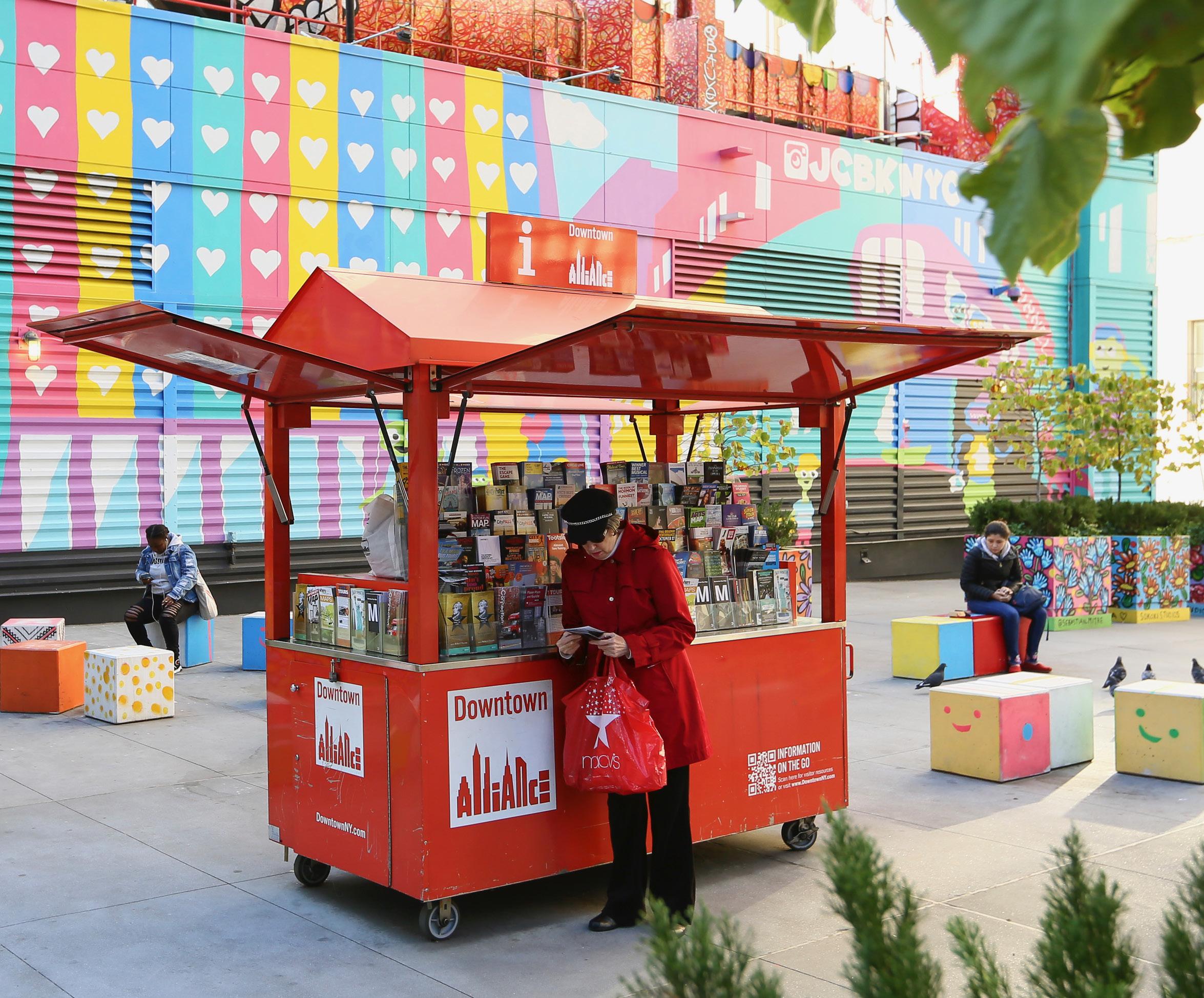

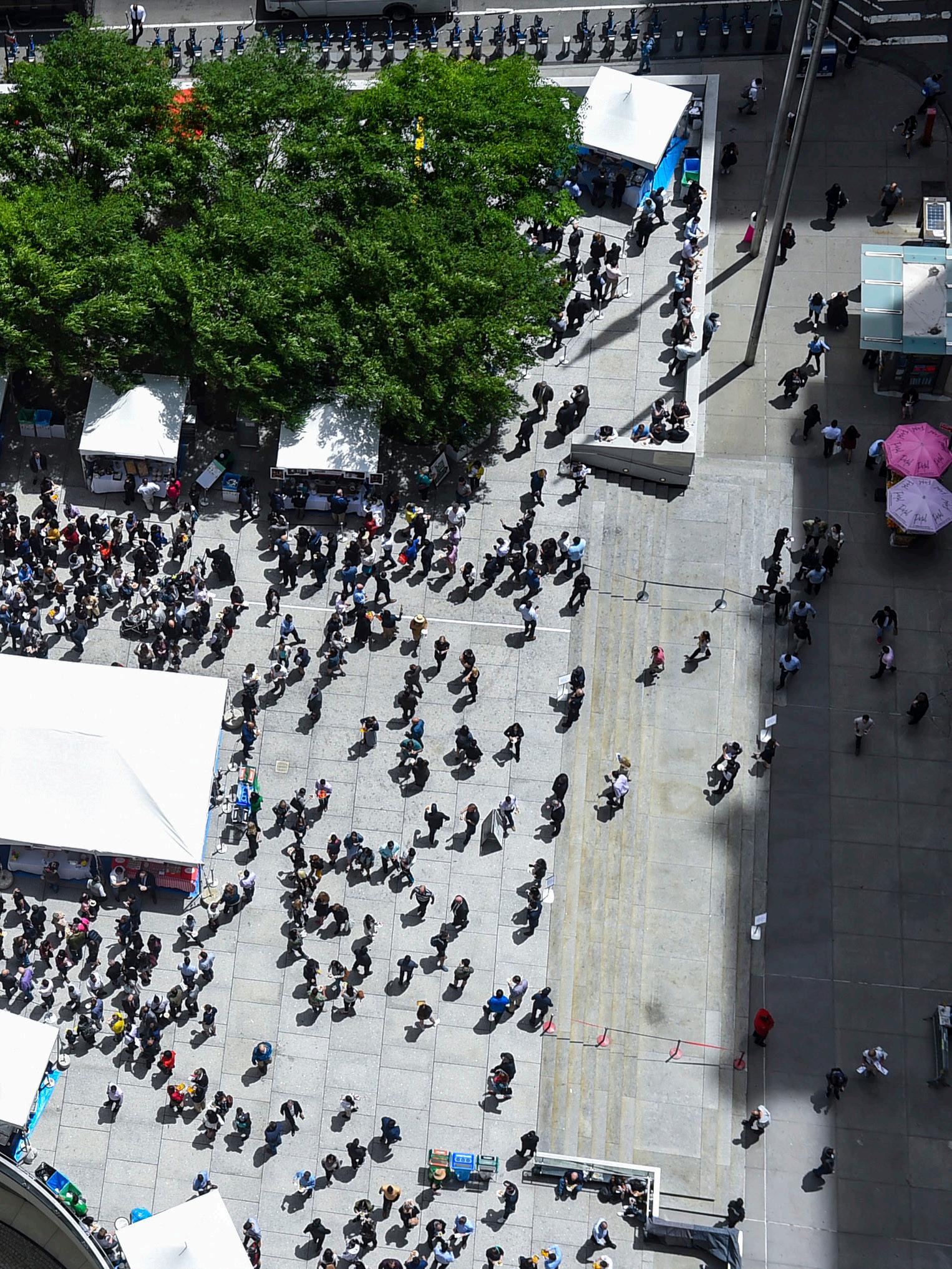
Dine Around Downtown, 2019
PUBLIC PROGRAMMING
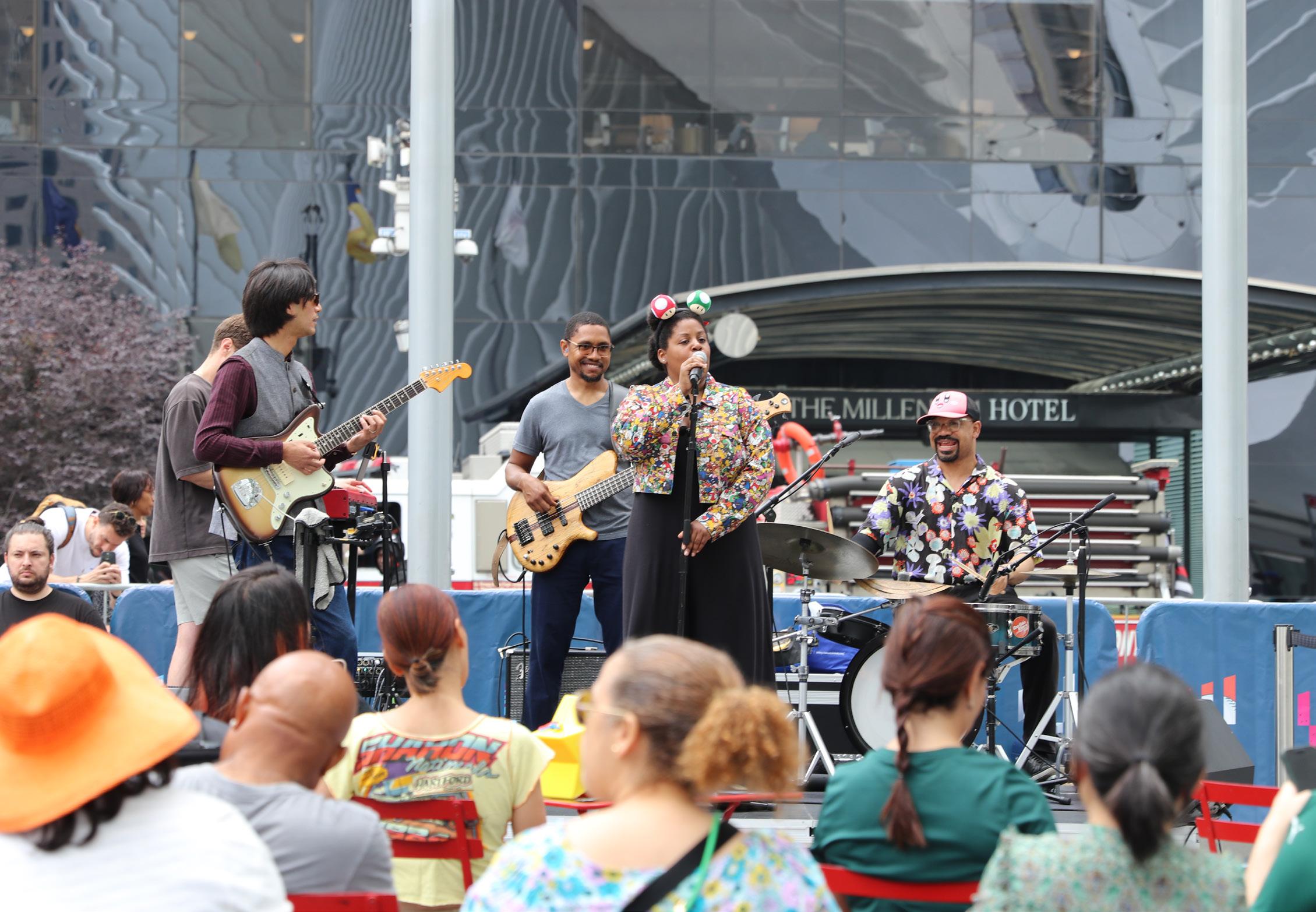
Since the Alliance’s founding, we’ve been bringing Lower Manhattanites together through a variety of free or affordable public programming. Whether supporting local restaurants with our annual food programming or turning downtown plazas into living rooms with free performances and public art, we’ve made a point to connect with the community over the years at our events.
Norman Edwards Jr performs on North Oculus Plaza as part of the Art Is All Around summer concert series in 2025.
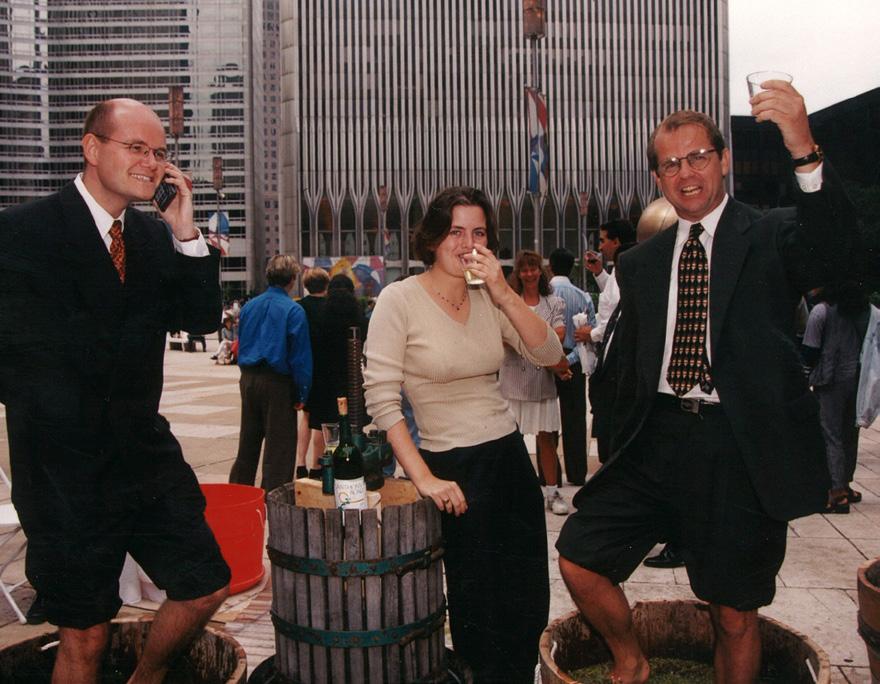
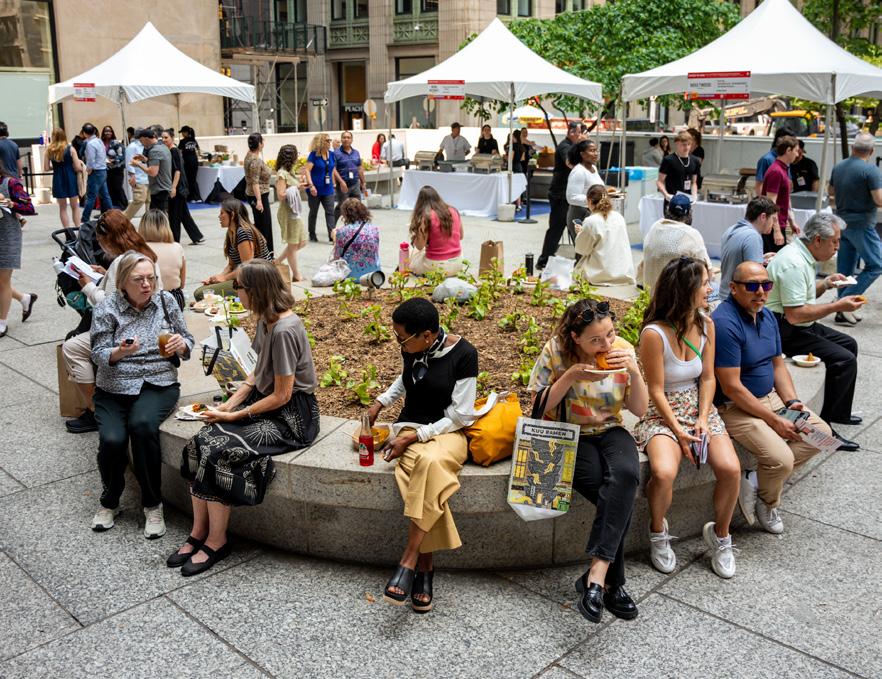
Our first Dine Around Downtown took place in September of 1997 at Wall and Broad streets to spotlight and celebrate downtown’s then small-but-mighty culinary scene. The event was sponsored by us and American Express, featuring around 20 local restaurants offering free food samples. The event was a hit, and moved to the World Trade Center Plaza where it remained until 2001. Post-9/11, we resumed our Dine Around Downtown event in May 2002 at then-One Chase Manhattan Plaza (now Fosun Plaza) and the neighborhood showed up in droves to support. In the years since, Dine Around Downtown has been a local favorite, returning to the plaza year after year, which drew some 15,000 attendees.
When shutdowns were imposed to curb the spread of the Covid-19 virus, downtown’s restaurants faced a very real threat of their own. The Alliance’s Dine Around Downtown team recognized this and swiftly launched the virtual “Dine Around Downtown: Cooking at Home” series to help promote the neighborhood’s culinary scene from home. Hosted by James Beard Award-winning celebrity chef and TV personality Rocco DiSpirito, June 2020’s first installment in the virtual series drew more than 800 registrants, all of whom received pre- and post-event communications sharing information about the restaurant, the chef and featured recipes. We kept the program going throughout the height of the pandemic, and continued to produce special episodes even after the city opened back up, engaging more than 5,700 registrants.
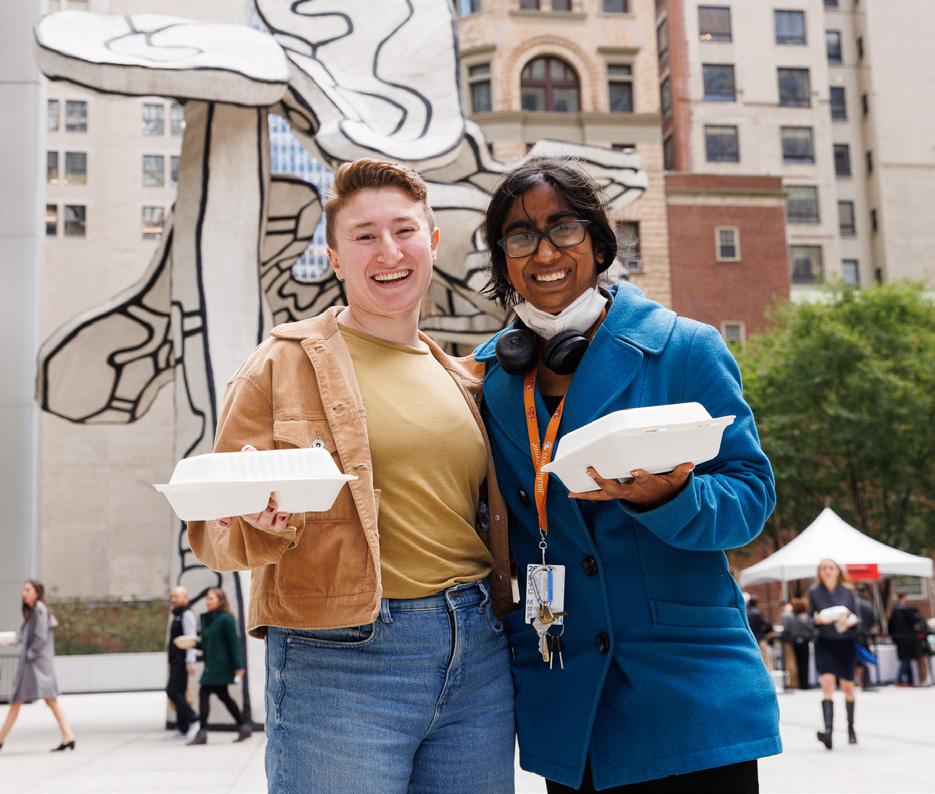
And in 2022, we expanded the Alliance’s Dine Around Downtown universe with Lunch Box, a one-day fall food festival featuring curated $10 lunch boxes from 10 of the newest downtown restaurants. Over the years, our food programming has helped bolster and expand downtown’s dining options so much that our 2025 Lunch Box event welcomed more than 5,000 attendees to Fosun Plaza.
The first Dine Around Downtown featured a “wine stomp” to celebrate New York State’s grape harvest.
Dine Around Downtown, 2025
Lunch Box, 2023
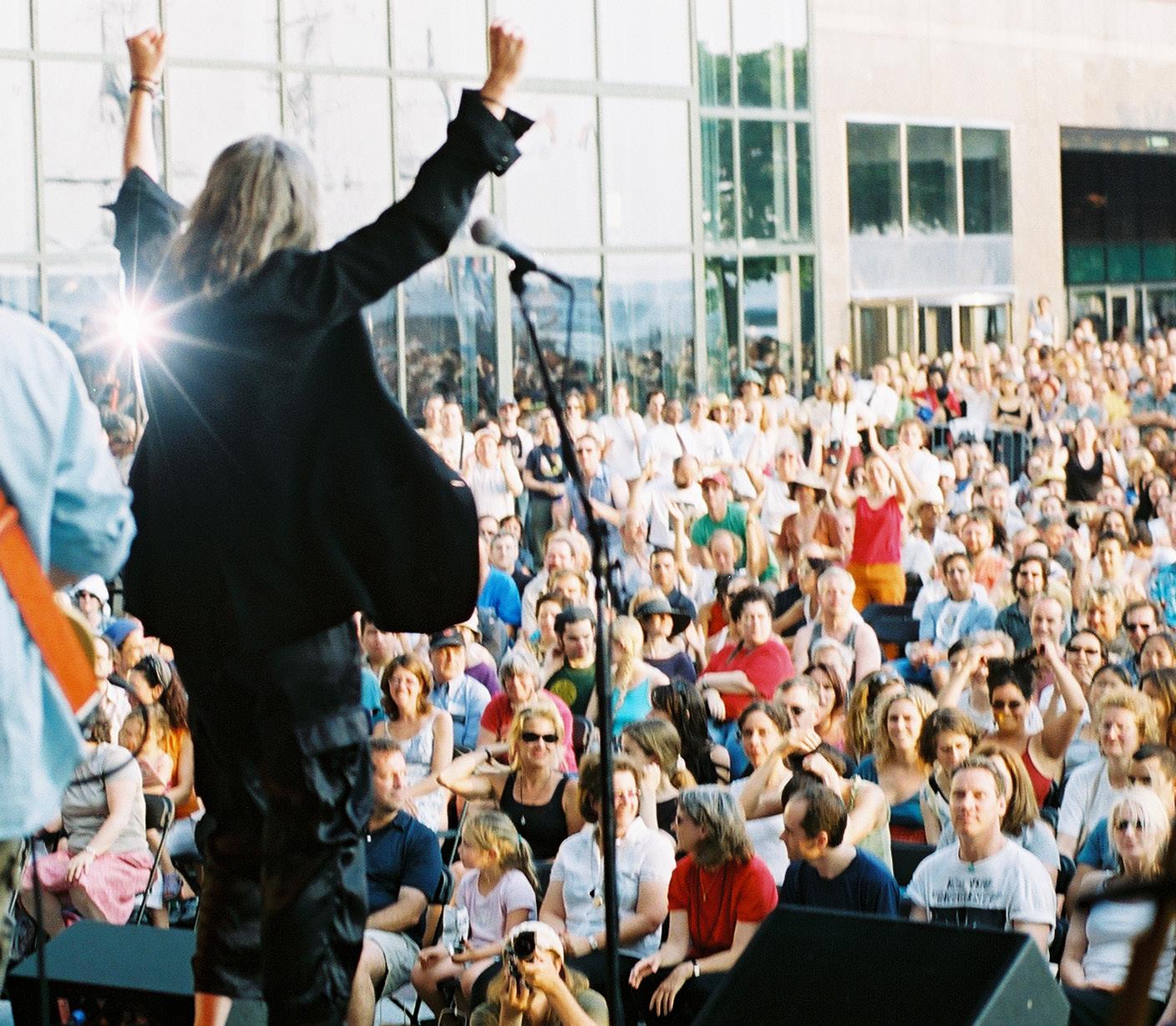
To help the neighborhood heal post-9/11, we started the River to River Festival in 2002 with generous support from American Express and combined efforts from the Port Authority of New York and New Jersey, Arts Brookfield and the Battery Park City Authority. The first festival was a hit, drawing A-list talent like James Brown, Sheryl Crow and Wynton Marsalis to perform and brought more than a million people and countless dollars to the neighborhood. The festival was also a financial boon for downtown, bringing an estimated $32 million in revenue to Lower Manhattan in 2003 alone. For more than a decade, the festival returned year after year with big names and bold performances from the likes of Belle and Sebastian, Fountains of Wayne, Savion Glover and more. Since the Downtown Alliance brought this endeavor to life, the festival has brought more than 500 free concerts, performances and art exhibits to Lower Manhattan.
Today, the annual festival founded by the Alliance is run by the Lower Manhattan Cultural Council (LMCC) and continues to bring performances and artistic experiences to hundreds of thousands of audience members.
The Downtown Alliance’s inaugural River to River Festival in 2002.
In 2005, we began the popular Downtown Third Thursdays free lecture series, which ran for five years until 2009. The series celebrated Lower Manhattan’s architectural treasures and history by presenting discussions with best-selling authors, historians and architects, including Santiago Calatrava, Rafael Viñoly, David Rockwell and Daniel Libeskind, in some of downtown’s most architecturally significant locations, many of which were not typically open to the public.
These events live on today as LM Live. LM Live is a programming initiative created by the Downtown Alliance to bring the Lower Manhattan community together around events that highlight the neighborhood’s talent, innovation, history and culture.
Since its establishment, LM Live has hosted cultural conversations that bring together thought leaders and innovators to discuss current issues affecting New Yorkers. Leveraging the rich talent and expertise in Lower Manhattan, these events offer the downtown community a chance to connect and build relationships around important topics. These conversations include panel discussions on state and city politics, and climate solutions and Roe v. Wade, as well as events focused on current events and hot topics, including art and architecture, public service law and child care policies.
In June 2022, LM Live established its popular “New York on Film" series, which features special screenings of quintessential New York films that shine a spotlight on the moments and cultural touchpoints that have defined Lower Manhattan and the city over the past century. These frequently sold-out screenings are followed by conversations with filmmakers, historians, activists and critics including Ken Burns, Philippe Petit and Michael Kimmelman.
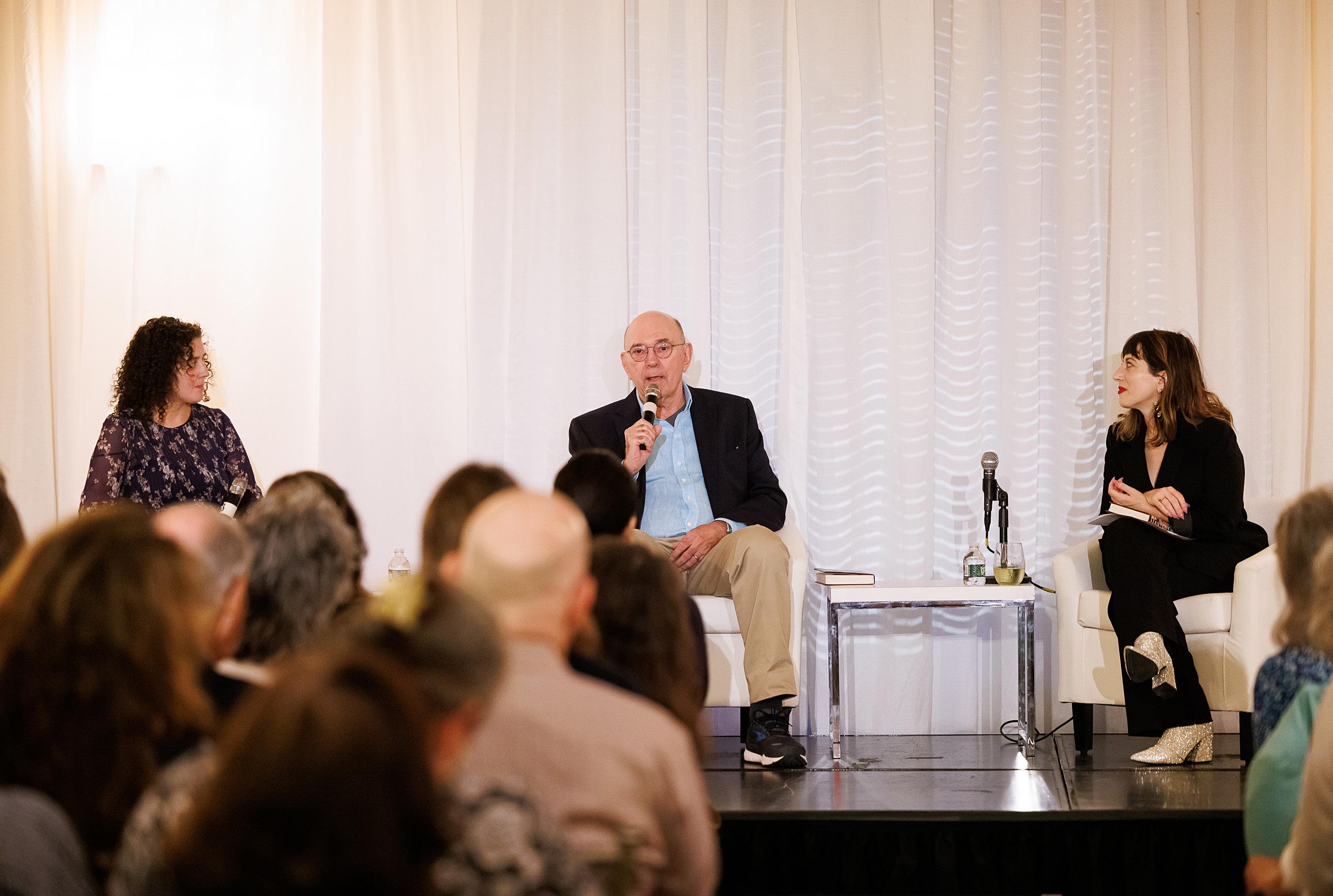
LM Live panel titled “Art, Ambition and Scandal in Gilded Age New York” on Tuesday, September 16, 2025.

In 2014, the Downtown Alliance launched its Game On! summer programming series that activated public spaces along the Water Street corridor with block parties featuring outdoor games like shuffleboard, foosball and cornhole. The program ran seasonally from 2014 to 2017, with games during the daytime, and music and refreshments starting after the workday ended.
Several years later, to supplement our Art Is All Around marketing campaign, we partnered with property owners in the district to bring installations from local and international artists to more than a dozen of the neighborhood’s public spaces. In spring 2019, we activated three POPS within the district with the Prismatica public art installation by Creos, and again with Oscillation by Creos in February 2020.
But as life changed during the pandemic, so did the neighborhood’s needs — and our economic development team realized the importance of richer engagement with the community at regular outdoor events. Since 2022, we have hosted a series of live outdoor concerts and performances annually in the district to encourage people to slow down and enjoy our public spaces during busy lunchtime and after work hours.
Past programming has included “Downtown Live” in spring 2021 with nonprofit theater group En Garde Arts, an exhibition with Art on the Ave in fall 2021 called “Resilience” which featured works for sale in storefront windows along Broadway, 2022’s “Downtown Stories” series of performances inspired by the people and places of Lower Manhattan with En Garde Arts and 2023’s Art Above the Mantel, a six-week stretch of holiday-themed visual art installations and events along the Nassau Street corridor with Art on the Ave. We also collaborated with award-winning architecture and design firm Hou de Sousa on interactive installations Ziggy in late 2020, Geo in 2023 and Star Light Star Bright in 2024, in which we partnered with local businesses to distribute wish ribbons for visitors to attach to a star-shaped structure.
FY 2025 by the Numbers
Number of LM Live events: 9
Attendees at Dine Around Downtown 2025: 15,000
Game On!, 2017


Star Light Star Bright Neighborhood Partners:
2025 Art Is All Around summer concert series attendees: 5,700
Art Above the Mantel, 2023
Geo NYC art installation, 2023
ADVOCACY
Beyond the visible efforts that are easy to glean from a stroll down our streets, the Alliance’s advocacy impacts both the policy and investment that shape Lower Manhattan. Throughout the last 30 years, the Alliance has advocated for the neighborhood everywhere from local community board meetings to City Hall to the state capitol in Albany, helping pass important zoning changes, tax incentives and housing initiatives that encourage neighborhood growth and prosperity. And we will continue to do so.
In our earliest days, the Alliance lobbied for and helped pass the 421-g real estate tax abatement program in 1995, which spurred the first wave of office-to-residential conversions across the neighborhood, long before the development trend caught on in central business districts around the country. This incentive crucially gave developers a tax break to renovate buildings built before 1975 south of Chambers Street, which made the bottom line feasible for conversions. The legislation was active for 11 years and catalysed the exponential residential growth Lower Manhattan has experienced from 14,000 residents, growing to nearly 70,000. Today, much of the neighborhood and the city’s overall landscape can be attributed to the Alliance’s influence on redeveloping older building stock into housing options.



After September 11, 2001, the Alliance began advocating for the creation of direct rail links to the suburbs and major airports, enhancement of PATH lines, a permanent PATH station and a new Fulton Center. In 2014, the new Fulton Center, designed by Grimshaw, opened and helped rationalize the jumble of transportation connections in Lower Manhattan. We also supported Mayor Michael Bloomberg’s proposal to establish a tax-free zone for international businesses that relocated to Lower Manhattan.
In Albany, we’ve met with state lawmakers, city officials and business leaders on countless issues that impact Lower Manhattan: from rallying for the renewal of the Lower Manhattan Relocation Employee Assistance Program (LM-REAP), which offers companies that relocate from other boroughs a tax credit of up to $3,000 per employee; to supporting the city’s Relocation Assistance Credit for Employees (RACE) pilot plan to provide an annual benefit per employee relocated from out of state for 10 years to the city; and establishing the NYC Childcare Property Tax Credit as part of the NYC Better Child Care Coalition alongside the District Council 37 labor union, the Real Estate Board of New York (REBNY) and all five New York City borough chambers of commerce, among others. Incentives like these support job growth and help businesses and talent stay in New York City.

Our efforts to secure funding for resilience projects in the wake of Hurricane Sandy, initiating transformative streetscape efforts along Water Street and pioneering public composting by working hand in hand with the Department of Sanitation on a pilot project have all borne fruit. More recently, by joining forces with a wide variety of local stakeholders, elected officials and the NYPD, our advocacy has helped usher in a multipronged effort to push back against predatory ticket sellers at the Battery.
Alliance staff also lead regular briefing meetings among commercial real estate professionals and marketing leads at major downtown institutions.

Ric Clark, Dan Goldman, Jessica Lappin (L to R), 2025

Alliance for Downtown New York Financial Statements
STATEMENT OF FINANCIAL POSITION
STATEMENT OF ACTIVITIES
BOARD OF DIRECTORS
Ric Clark, Chair Perelman Performing Arts Center (PAC)
Honorable Eric Adams* Mayor of the City of New York
Jason Beren Eastbridge Group
Anthony Cammarata Jr. Morgan Stanley
Betty Cohen Century 21 Department Stores
Tom Costanzo Fosun Hive Holding
K. Thomas Elghanayan TF Cornerstone Inc.
Lucy Fato
Seaport Entertainment Group
David V. Fowler
The Bank of New York Mellon
Will Goodwin New York Stock Exchange
Brett S. Greenberg Jack Resnick & Sons
Francis J. Greenburger Time Equities, Inc.
Elizabeth Hillman 9/11 Memorial & Museum
Thomas M. Hughes Residential Representative
Rev. Phillip A. Jackson Trinity Church Wall Street
Marvin Krislov Pace University
Jason Maurer Brookfield Properties
Sarah Miyazawa LaFleur M.M.LaFleur
Honorable Brad Lander* Comptroller, City of New York
Anita Laremont Fried Frank
Honorable Mark Levine* Manhattan Borough President
Honorable Christopher Marte* Council Member, City of New York
Nicholas Martin Rudin Management
Tammy Meltzer Manhattan Community Board 1
Jeremy Moss Silverstein Properties
Dr. Anthony Munroe Borough of Manhattan Community College
Dan Palino New Water Street Corp.
Edward V. Piccinich SL Green Realty Corp.
Peter A. Poulakakos Ahead Realty/HPH
Shinobu Ridley Stout NYC
Cynthia C. Rojas Sejas S&P Global
Joel Rosen GFI Development
Todd Schwartz Cushman & Wakefield
Frank J. Sciame
F.J. Sciame Construction Co., Inc.
Allan G. Sperling Cleary, Gottlieb, Steen & Hamilton, LLP
Brian R. Steinwurtzel GFP Real Estate
Kent M. Swig Swig Equities, LLC
Matthew Van Buren CBRE Group, Inc.
John Wheeler Jones Lang LaSalle
Jolene Yeats
The Port Authority of New York & New Jersey
Jessica Lappin President
* Designees of elected officials are directors.
STAFF
PHOTO CREDITS
IMAGE CREDITS:
Getty Images – Cover
Adam Lerner – 2
Rockefeller Archives – 4-5, 6
Robert Simko – 7
Museum of the City of New York – 7
Eli Tawil – 15
iStockphoto.com – 8, 11, 24
AP photographer (Sara Kerens) – 9, 12, 16, 18, 20, 27, 34-35, 39, 40, 41, 47, 50
AP photographer (Sophie Fjello-Jensen) –14, 15, 16, 18, 19, 21, 26, 32
Eli Tawil – 17
AP photographer (Stuart Ramson) – 19, 43, 56
AP photographer (Jason DeCrow) – 20,
AP photographer (Carla Torres) – 22
AP photographer (Loren Matthew Wohl) – 25, 29
Photo Courtesy of Printemps – 26
Photo courtesy of Gary Hershorn – 28
New York Magazine cover, Photograph by Iwan Baan, courtesy of New York Magazine – 30
AP photographer (Andrew Kelly) – 33
AP photographer (Diane Bondareff) – 36
AP photographer (Lanna Apisukh) – 38
Josh Katz – 39
Mark Weinberg – 40, 54-55
AP photographer (Diane Bondareff) – 44-45
AP photographer (Angelina Katsanis) – 47
Michael Hnatov – 51
ADNY – 46, 47, 48, 49, 54
Iwan Baan –52, 53
ART
